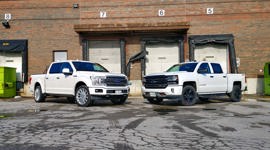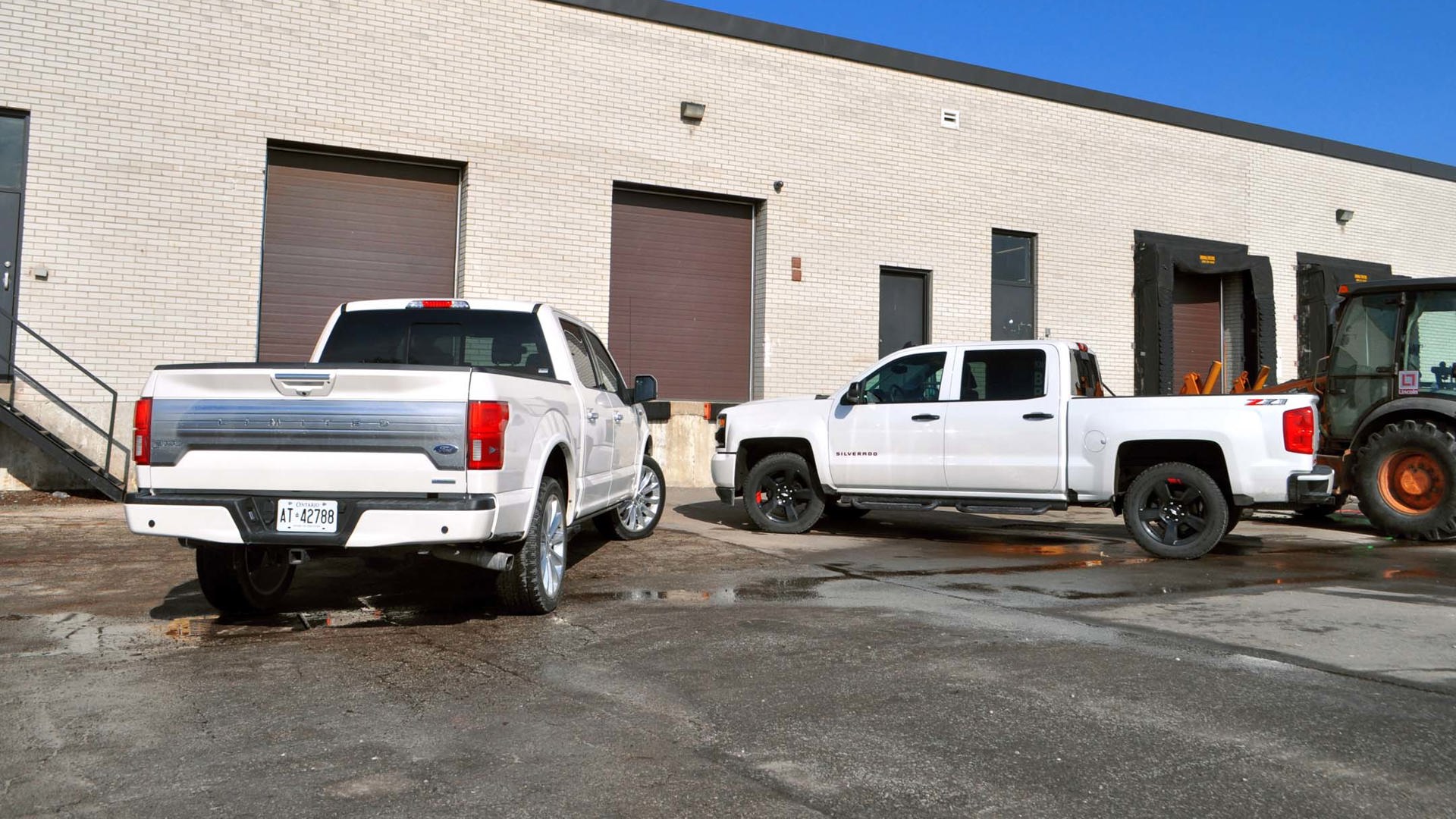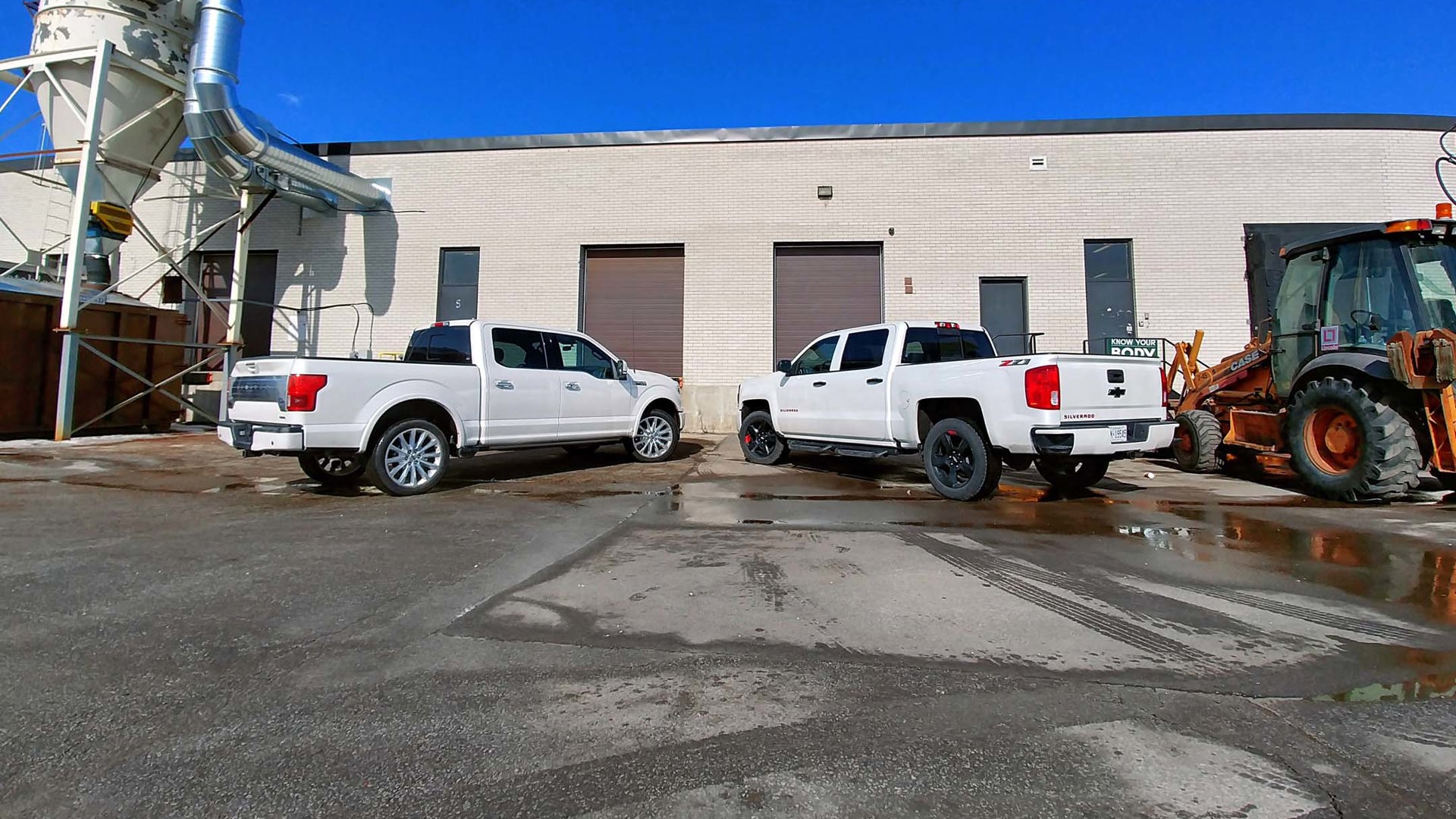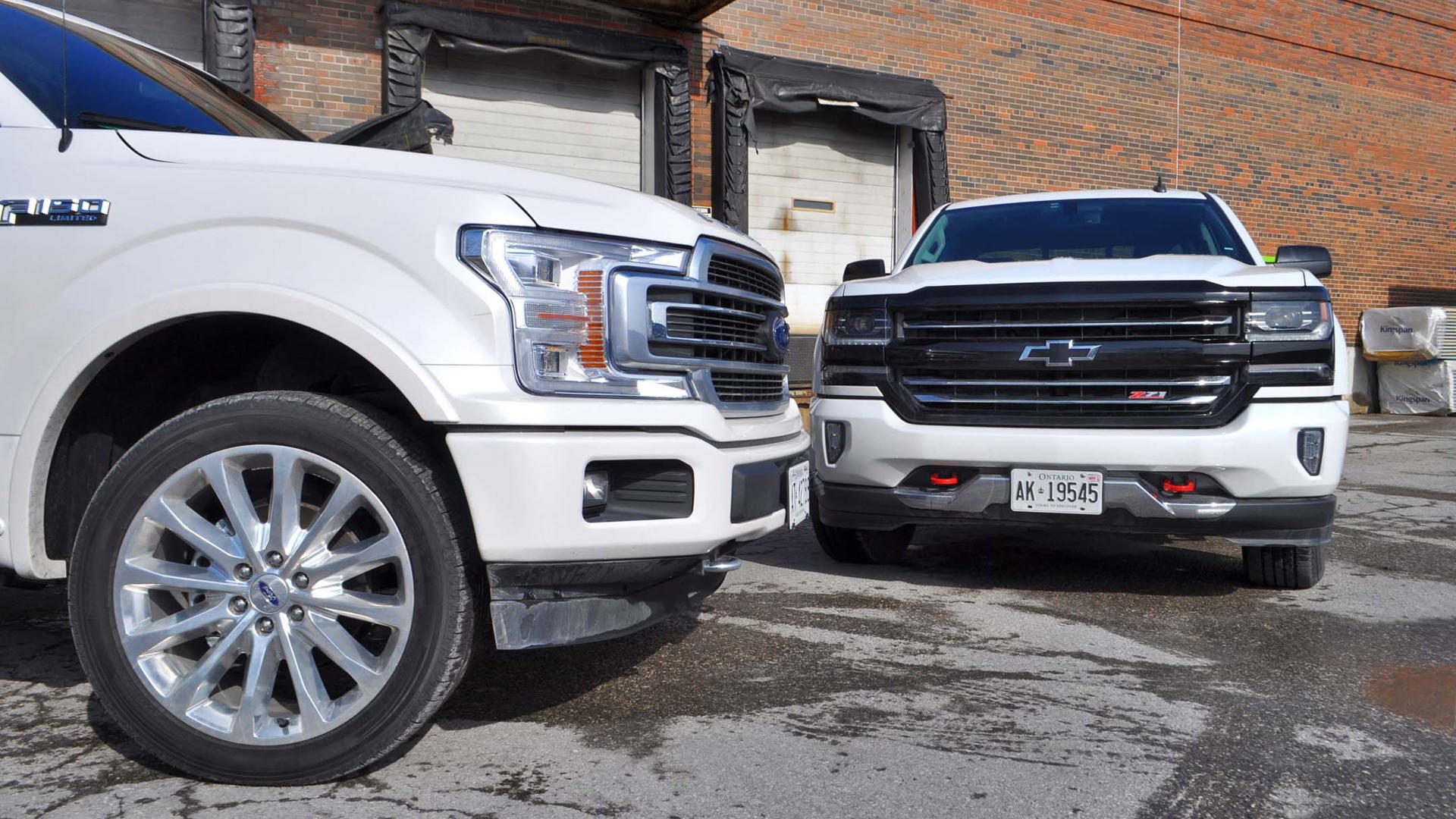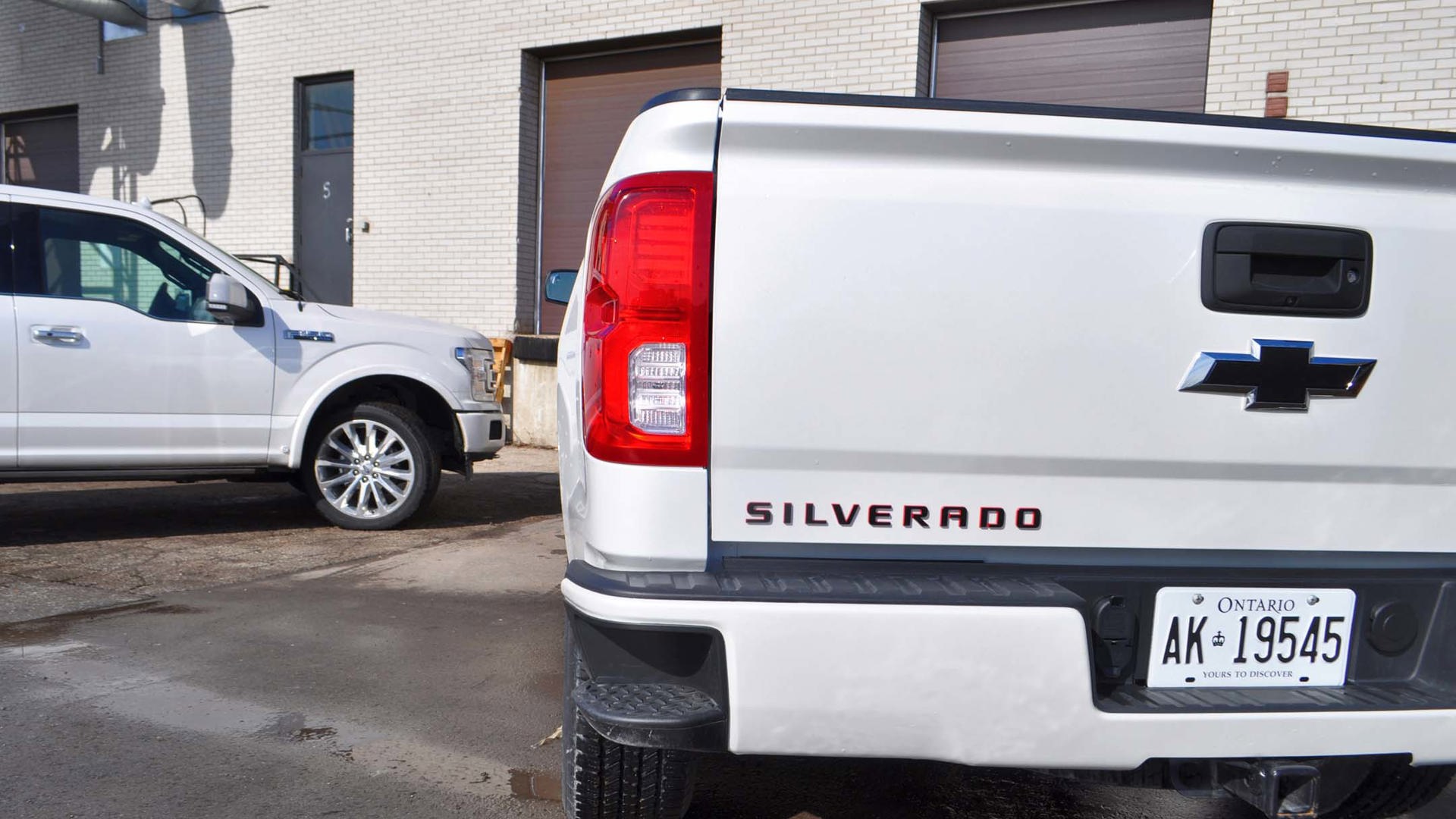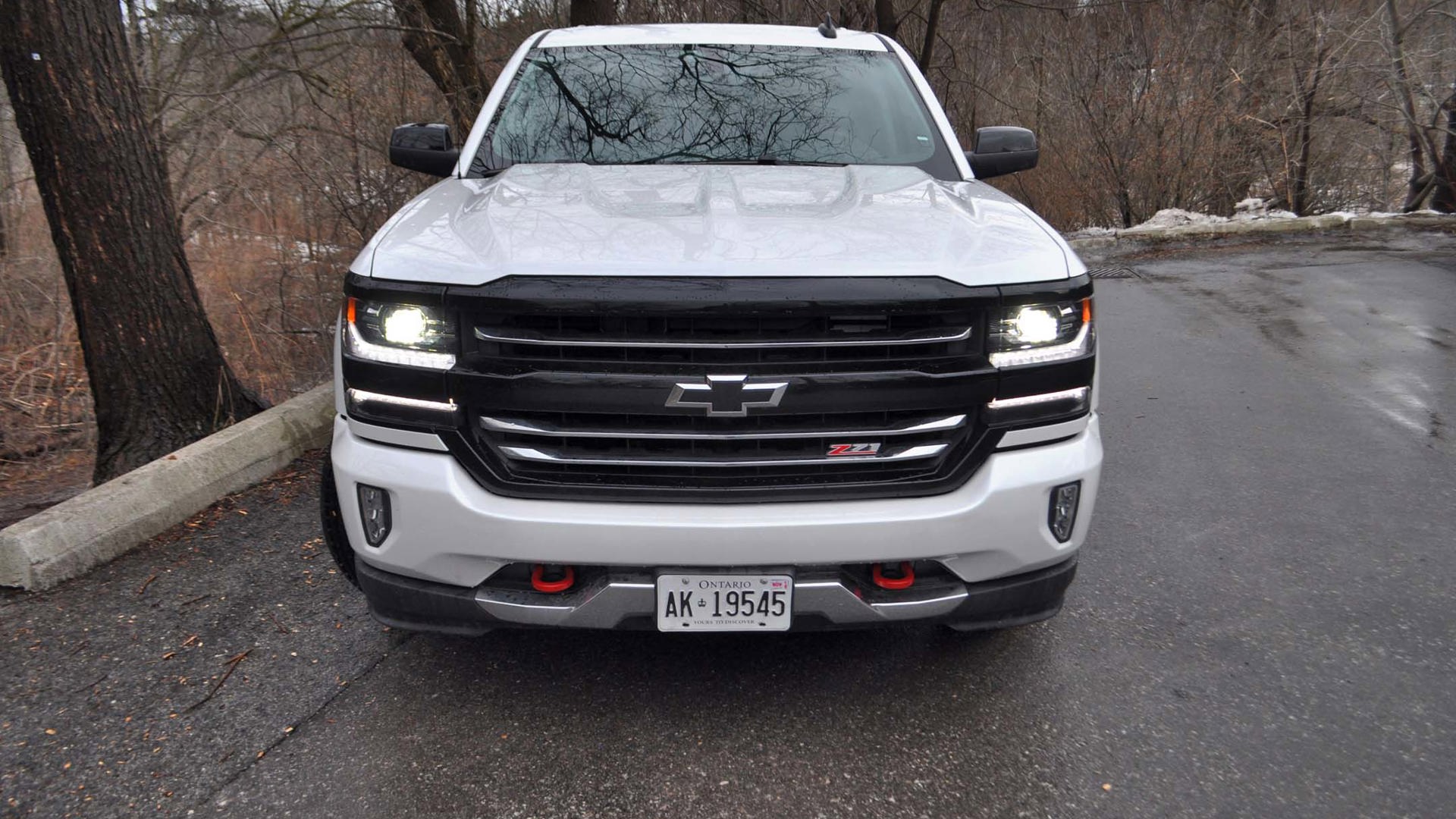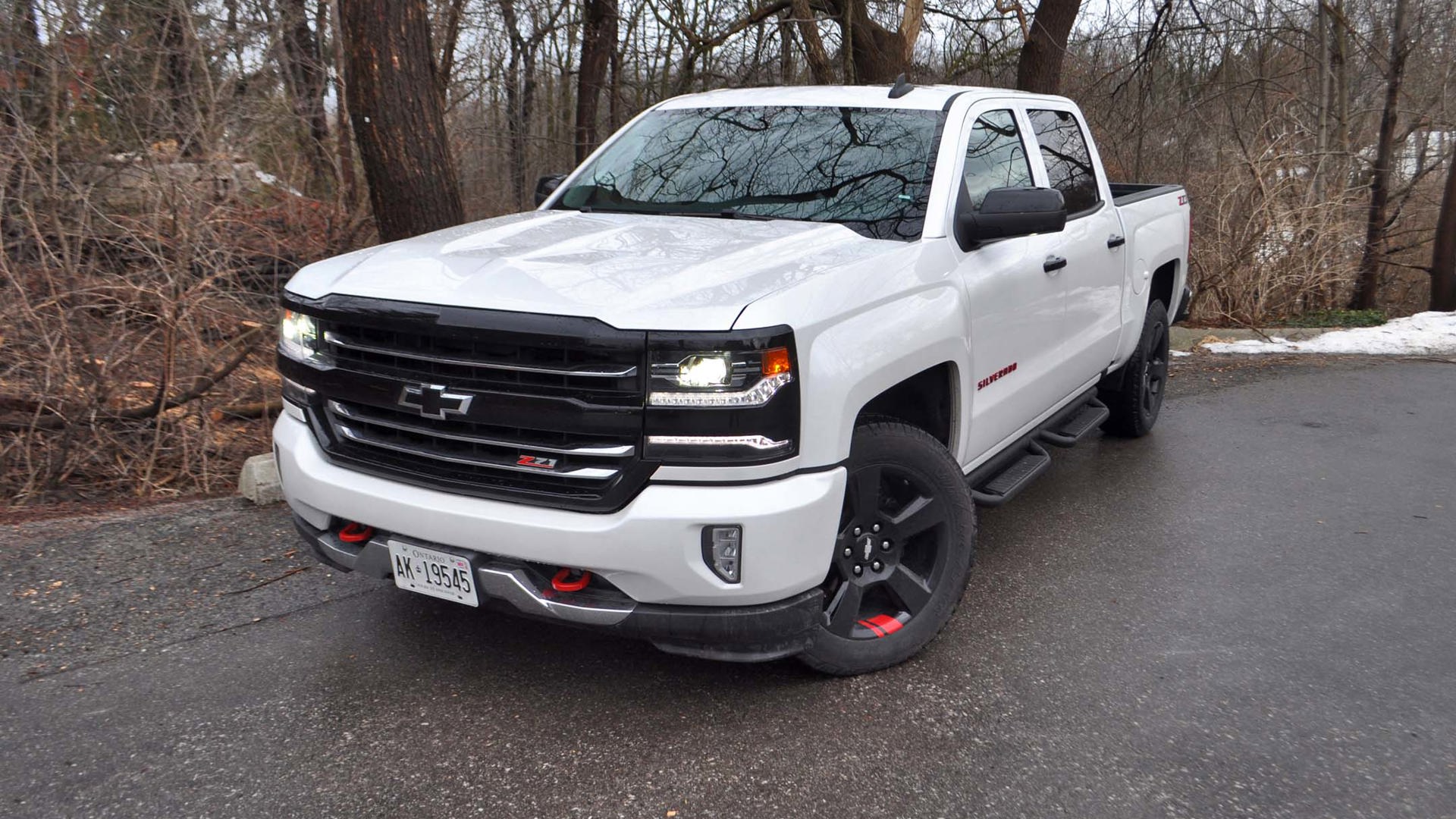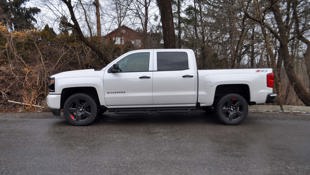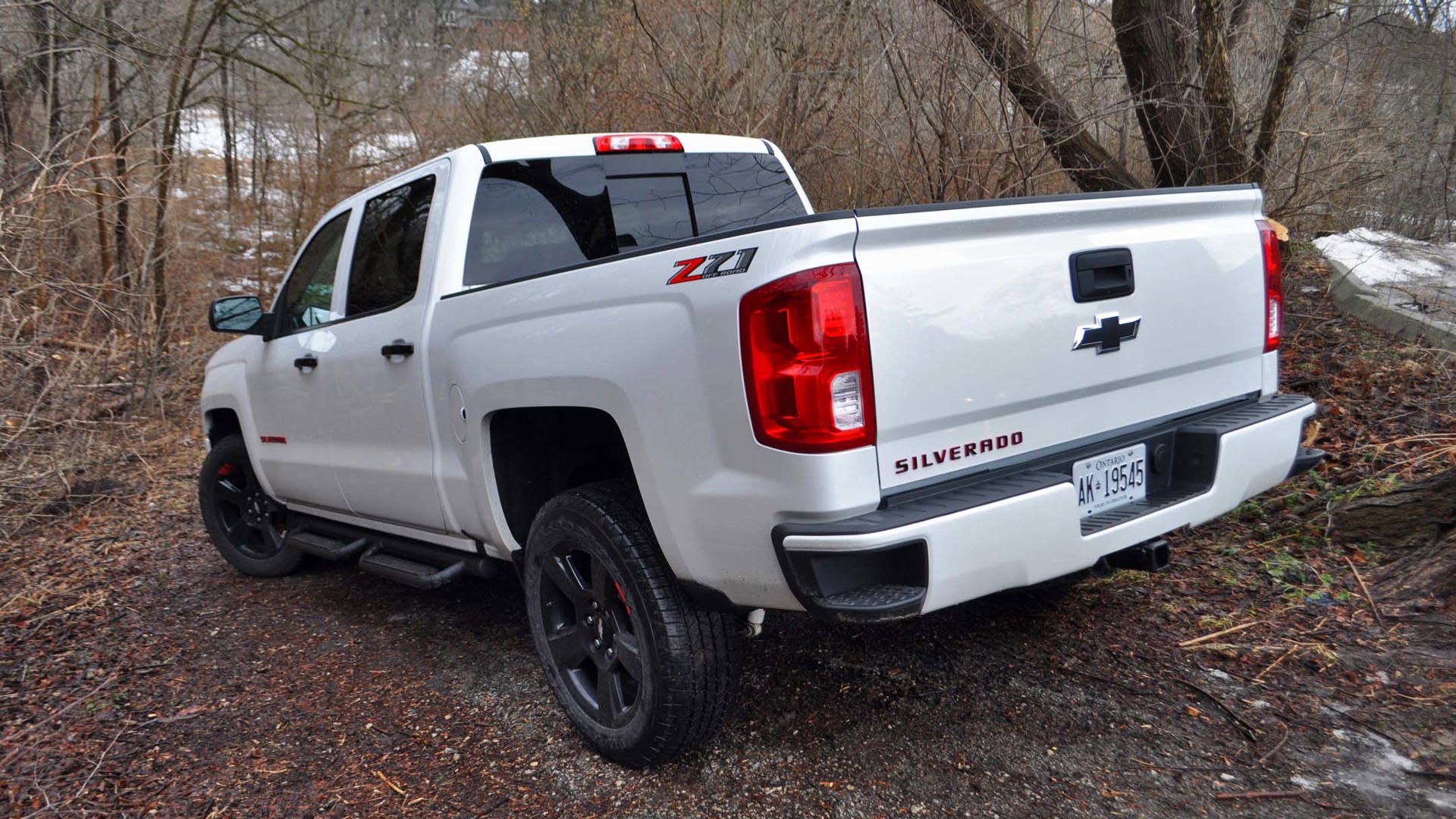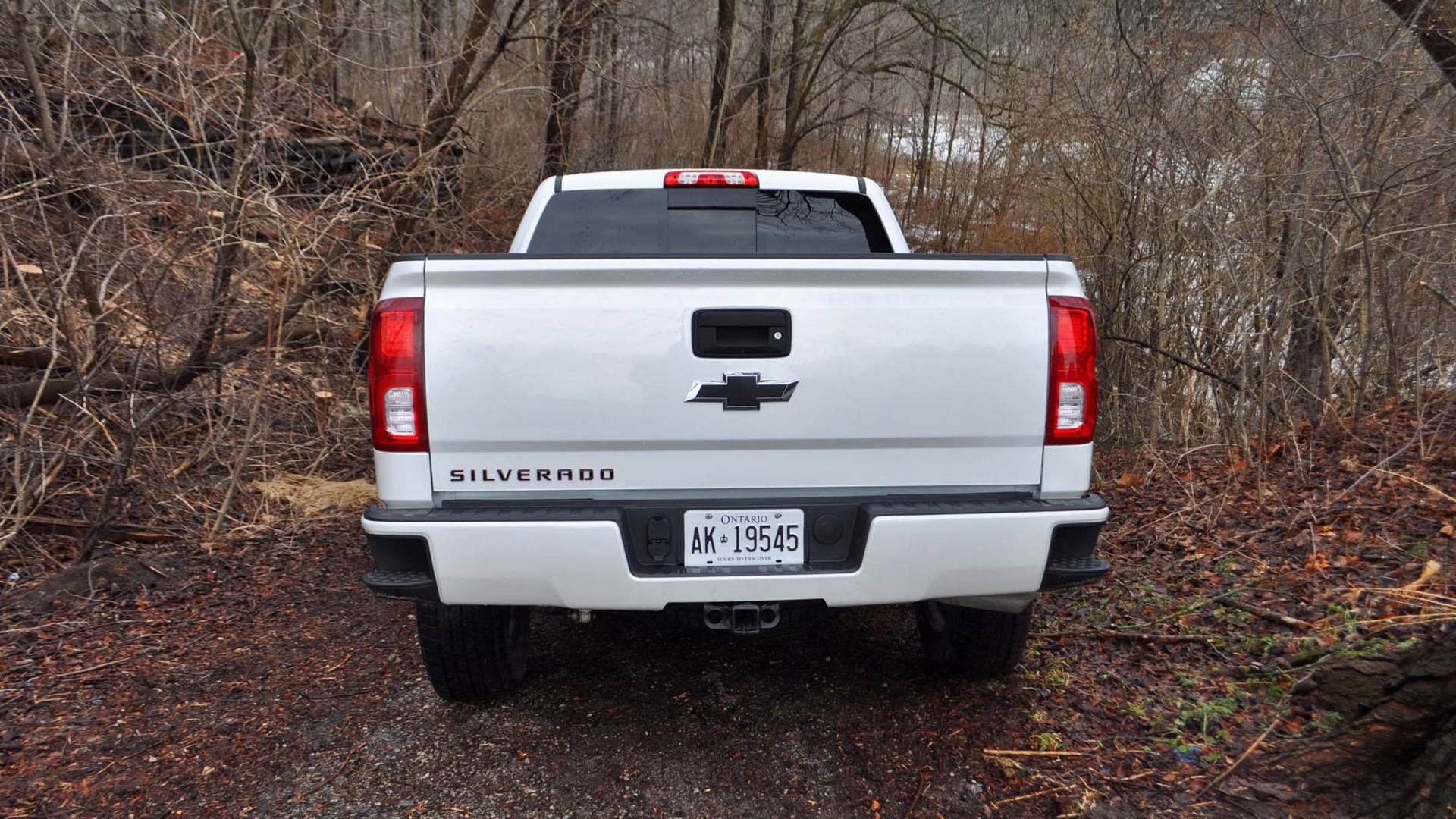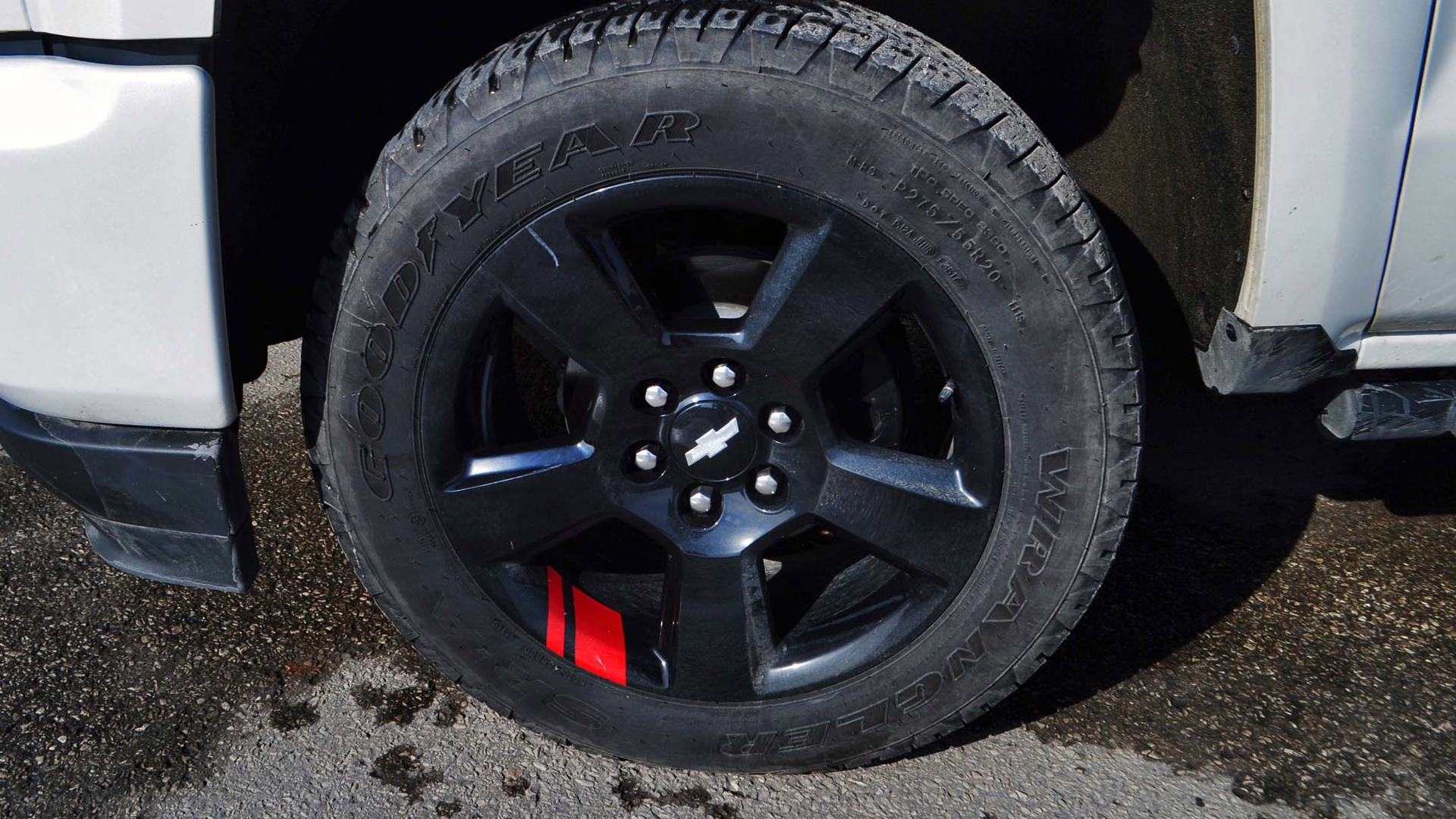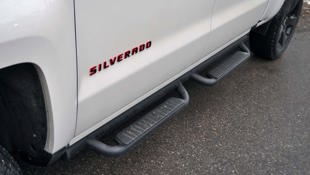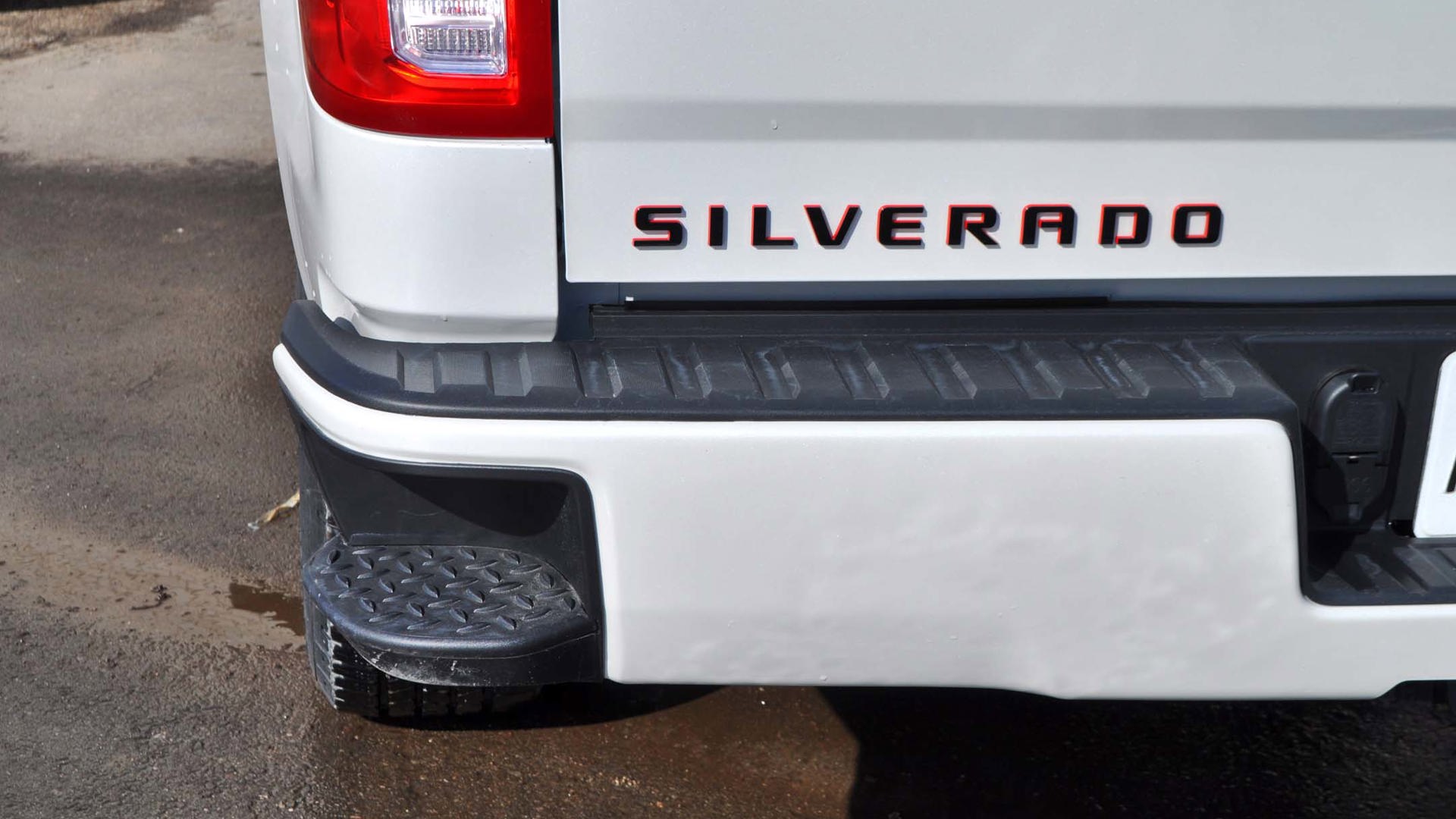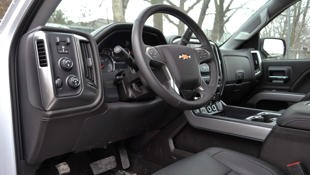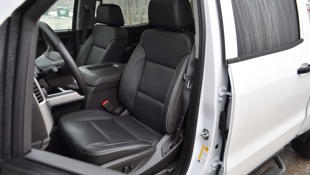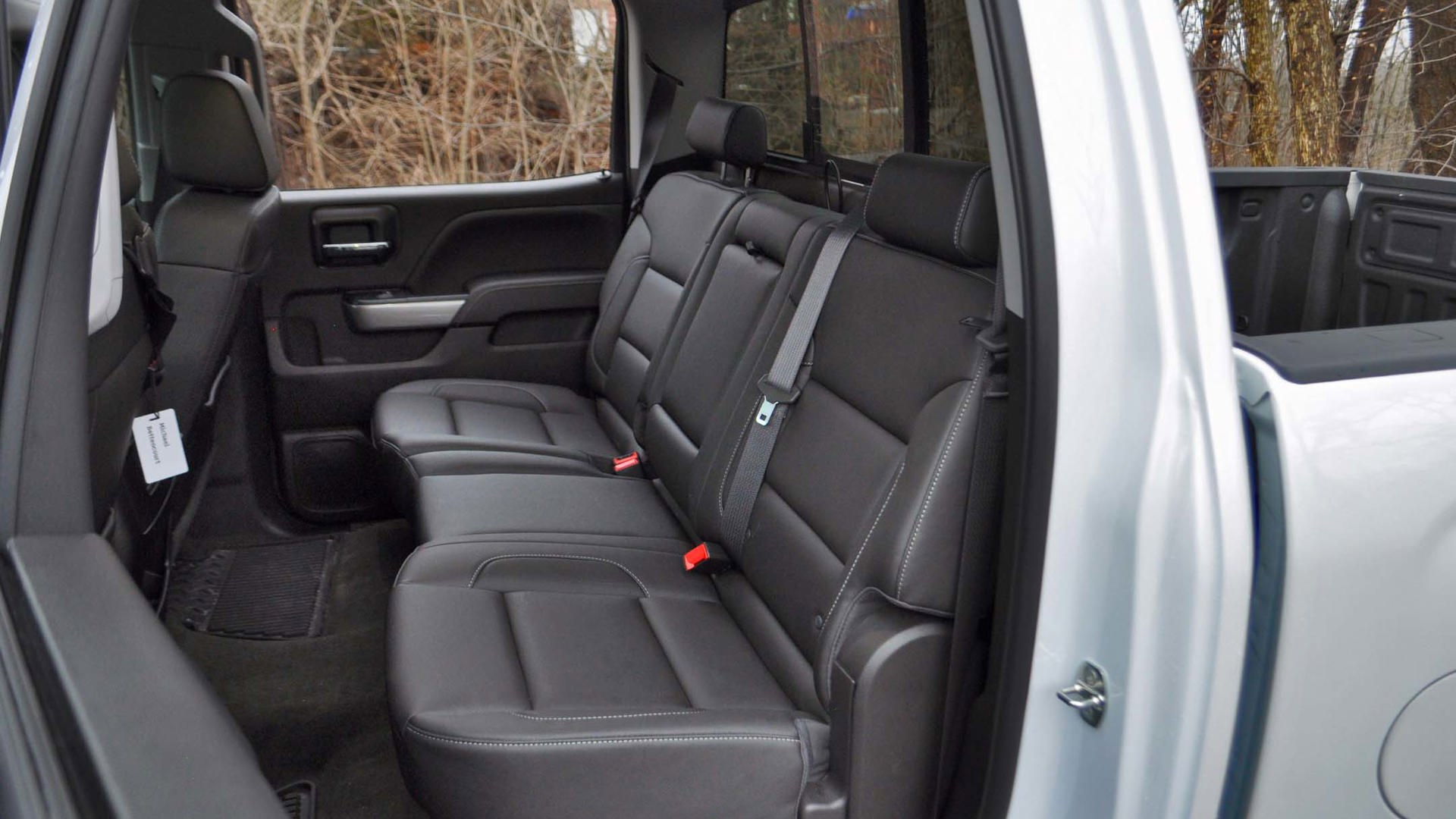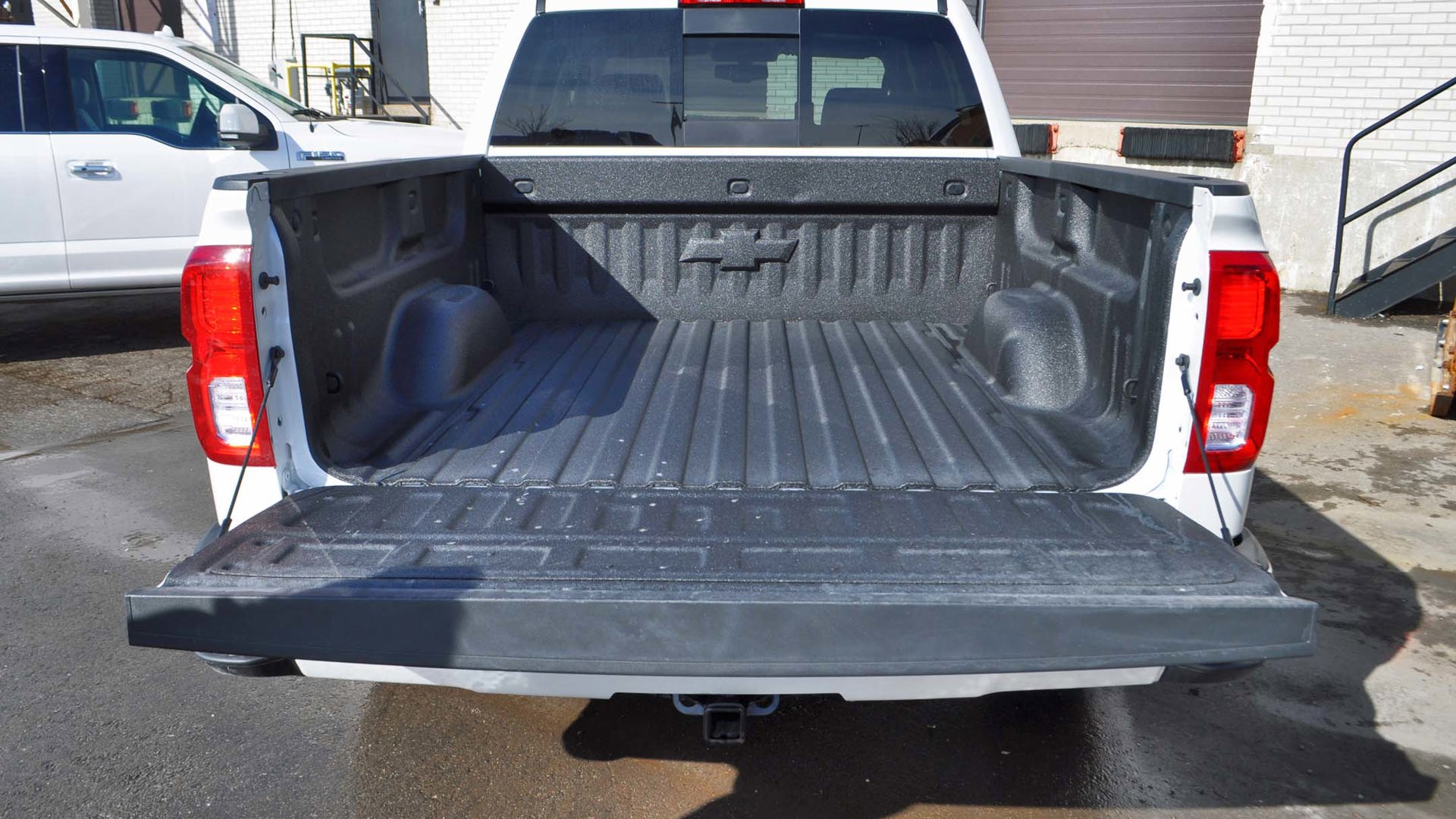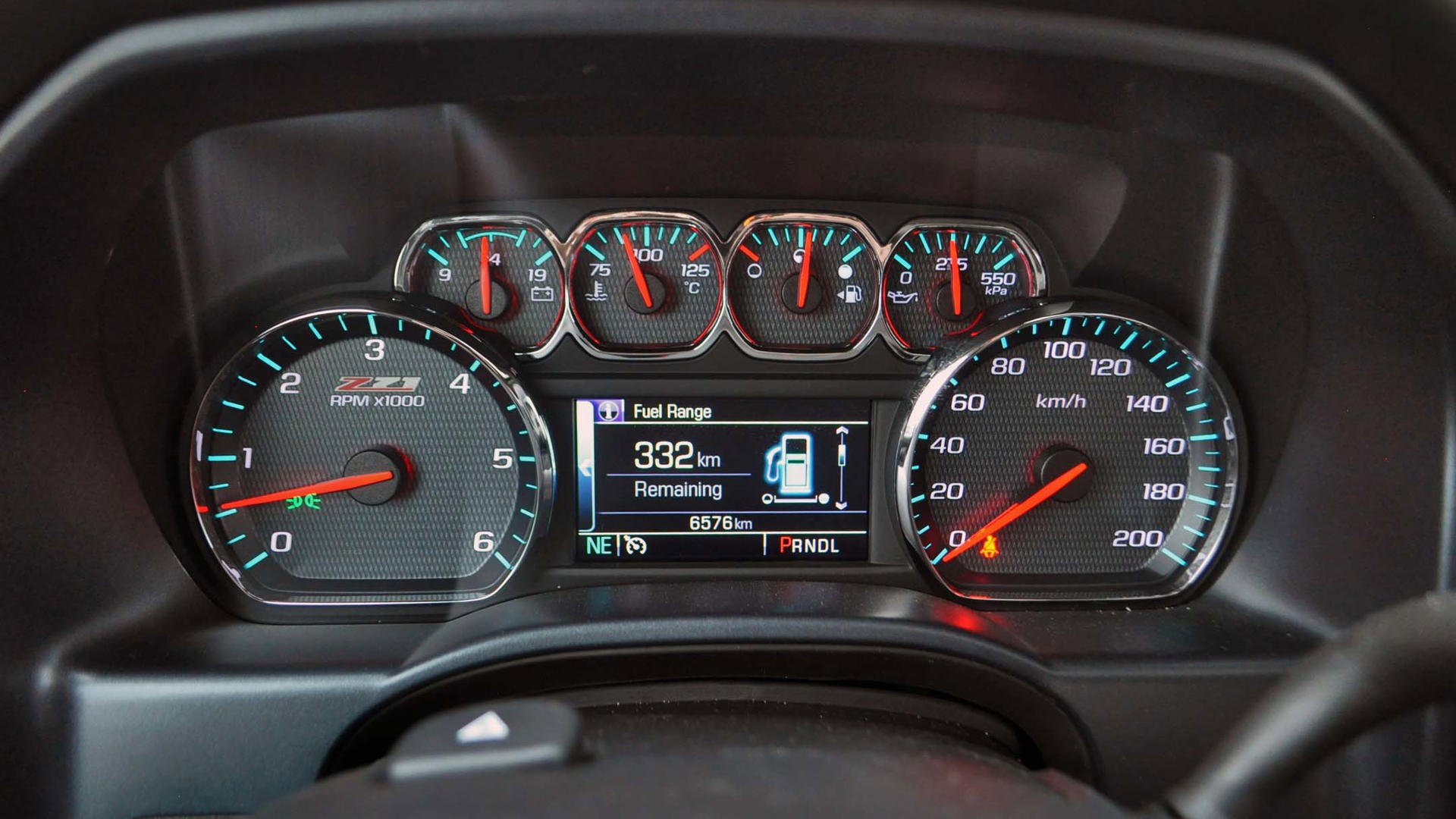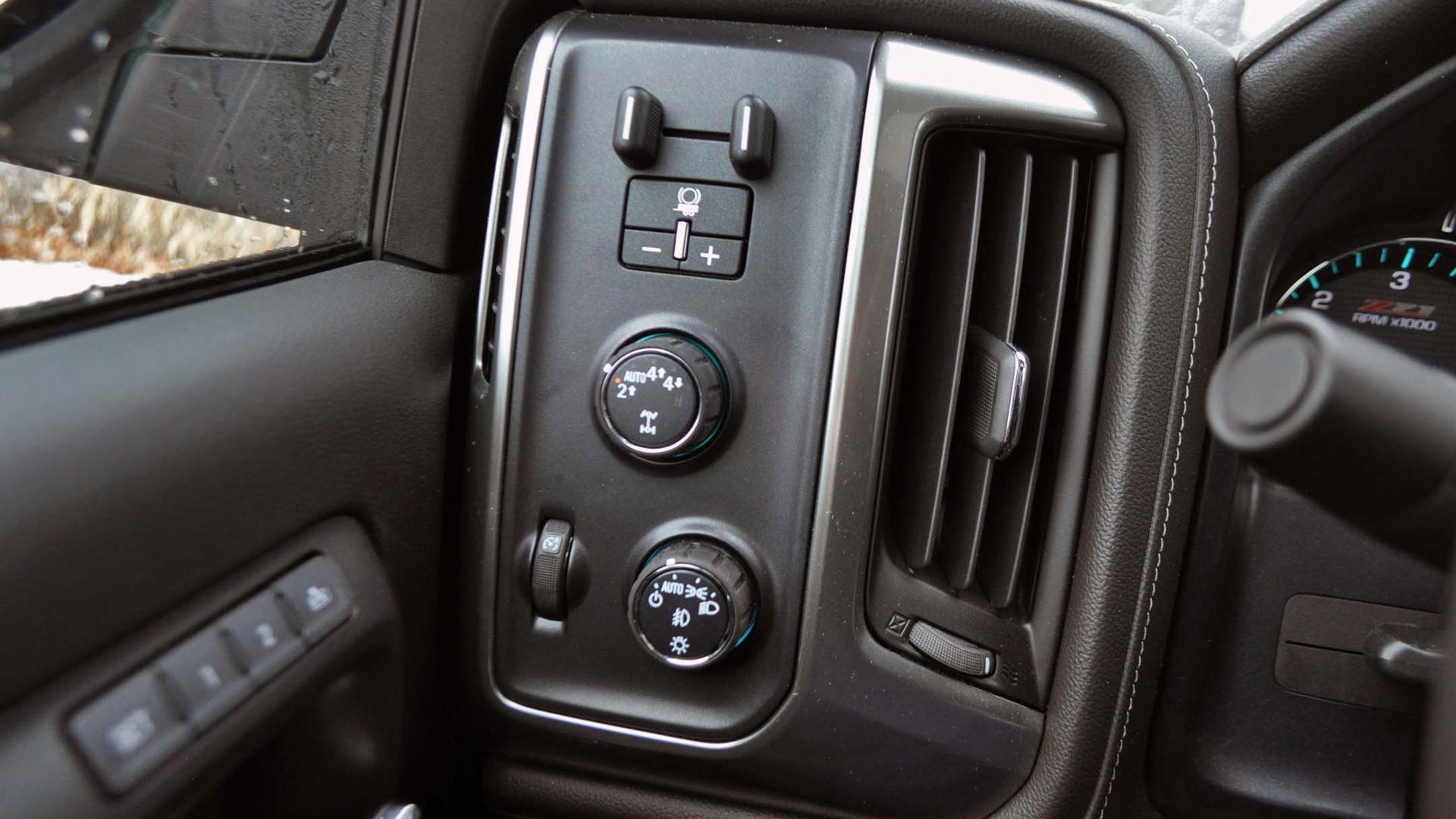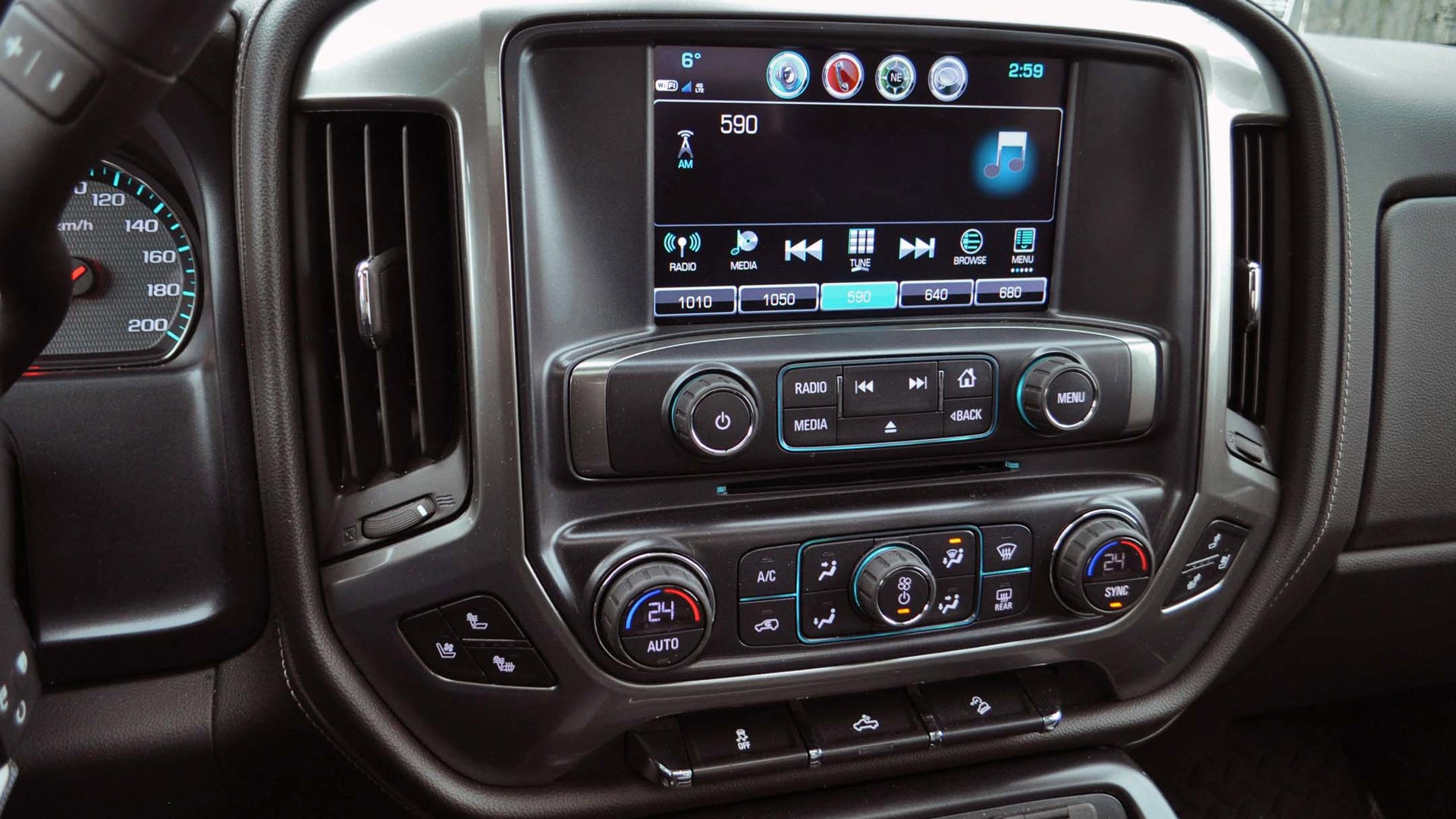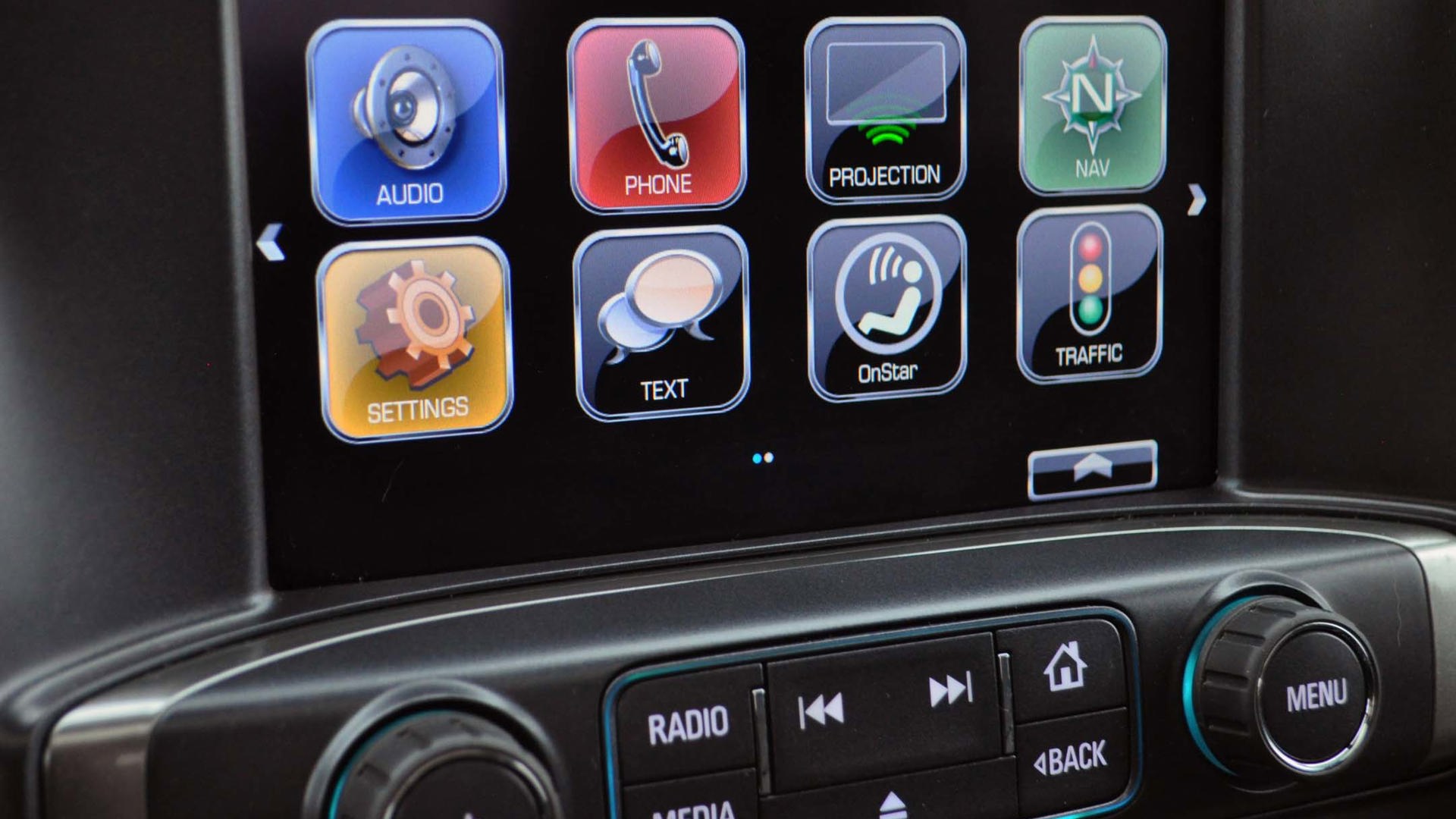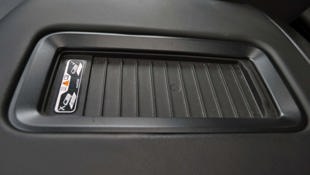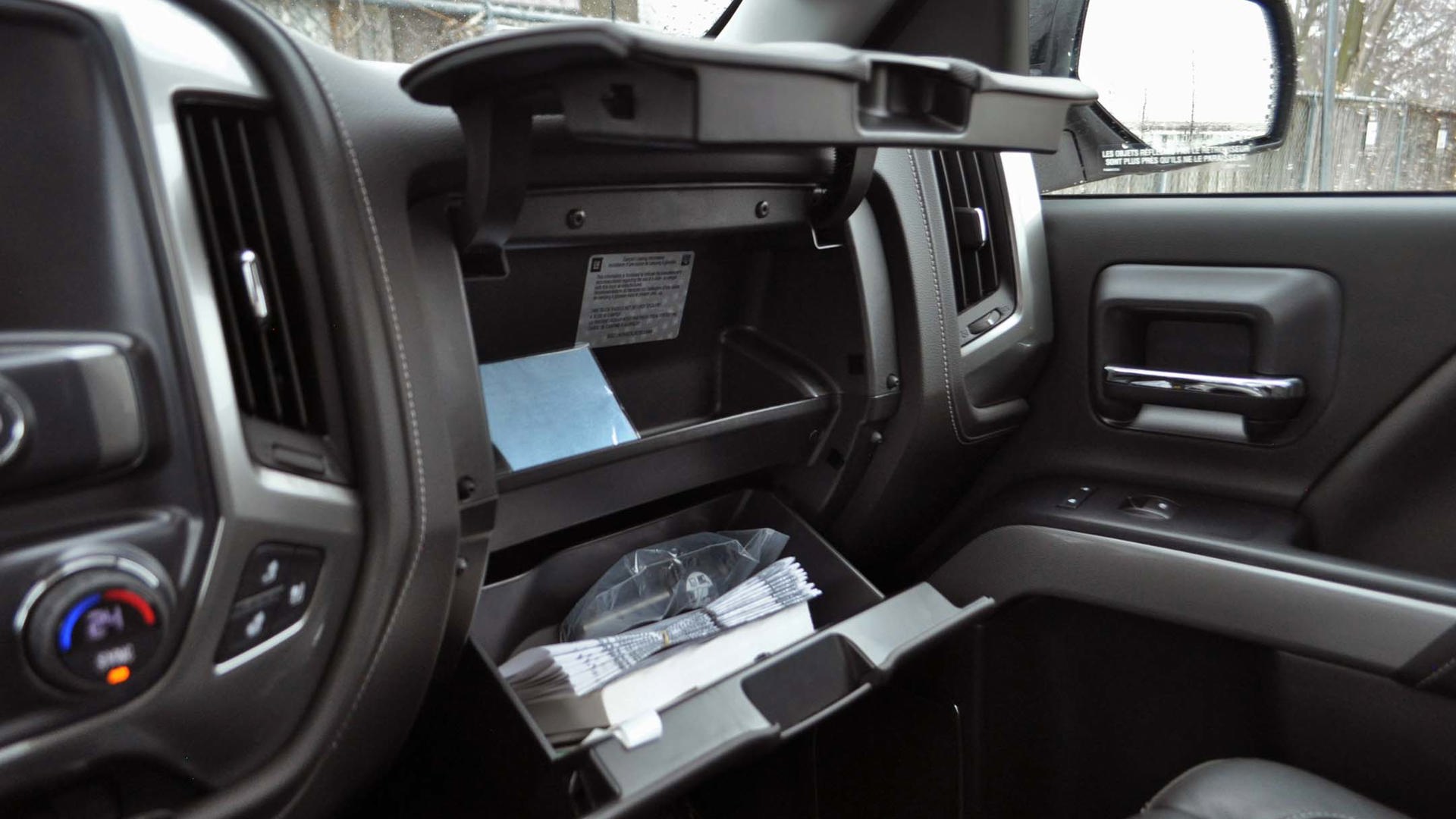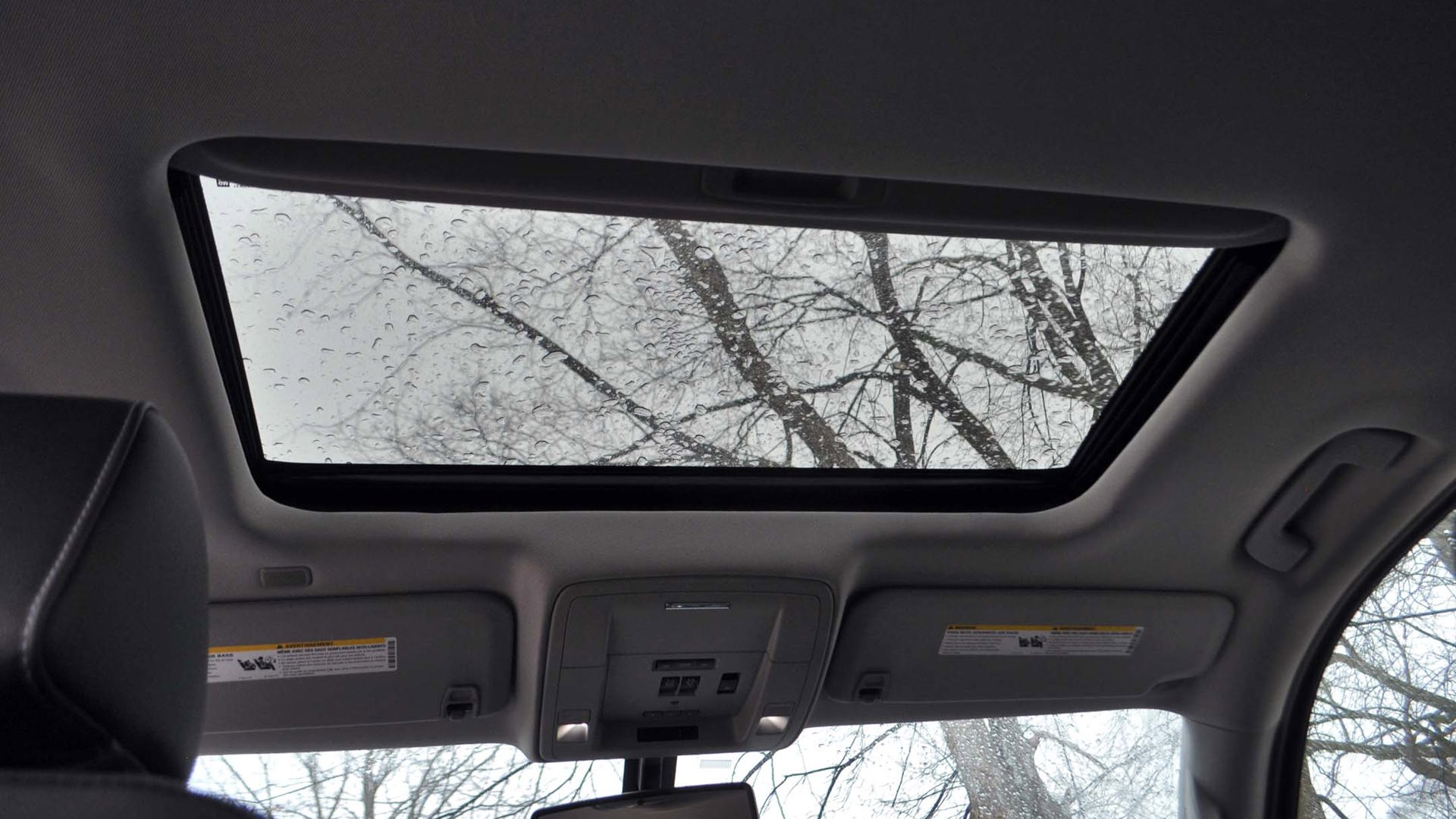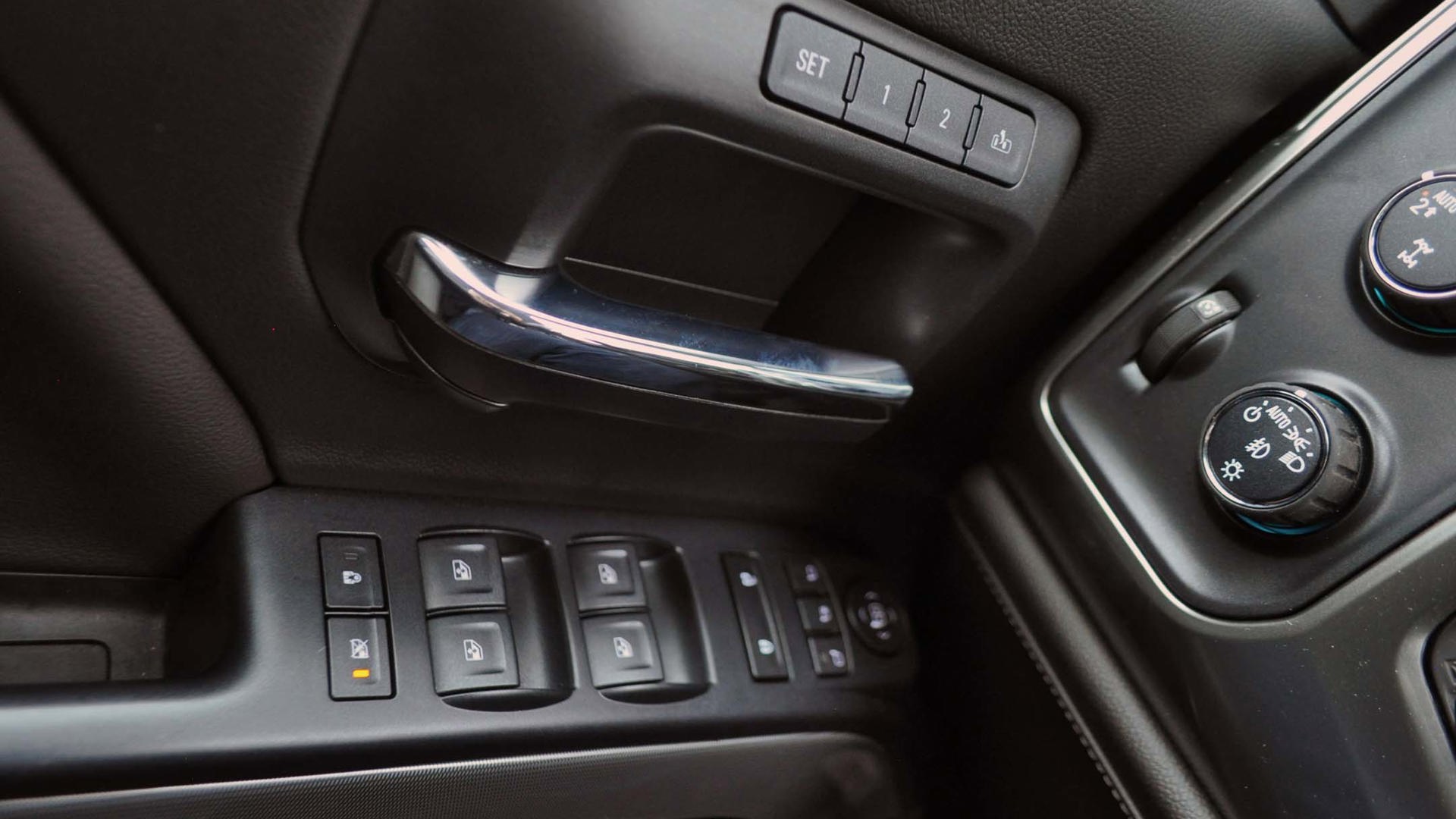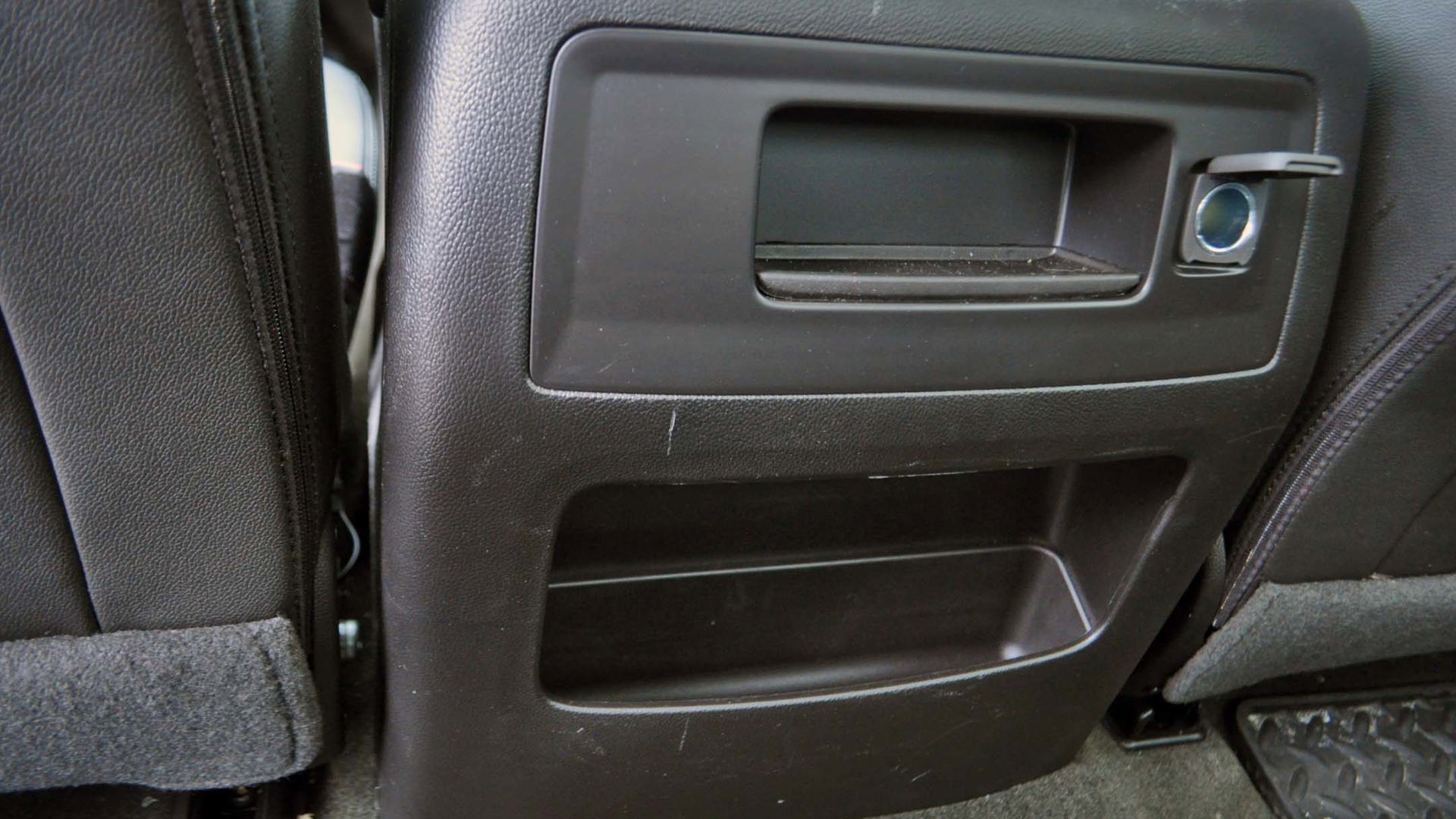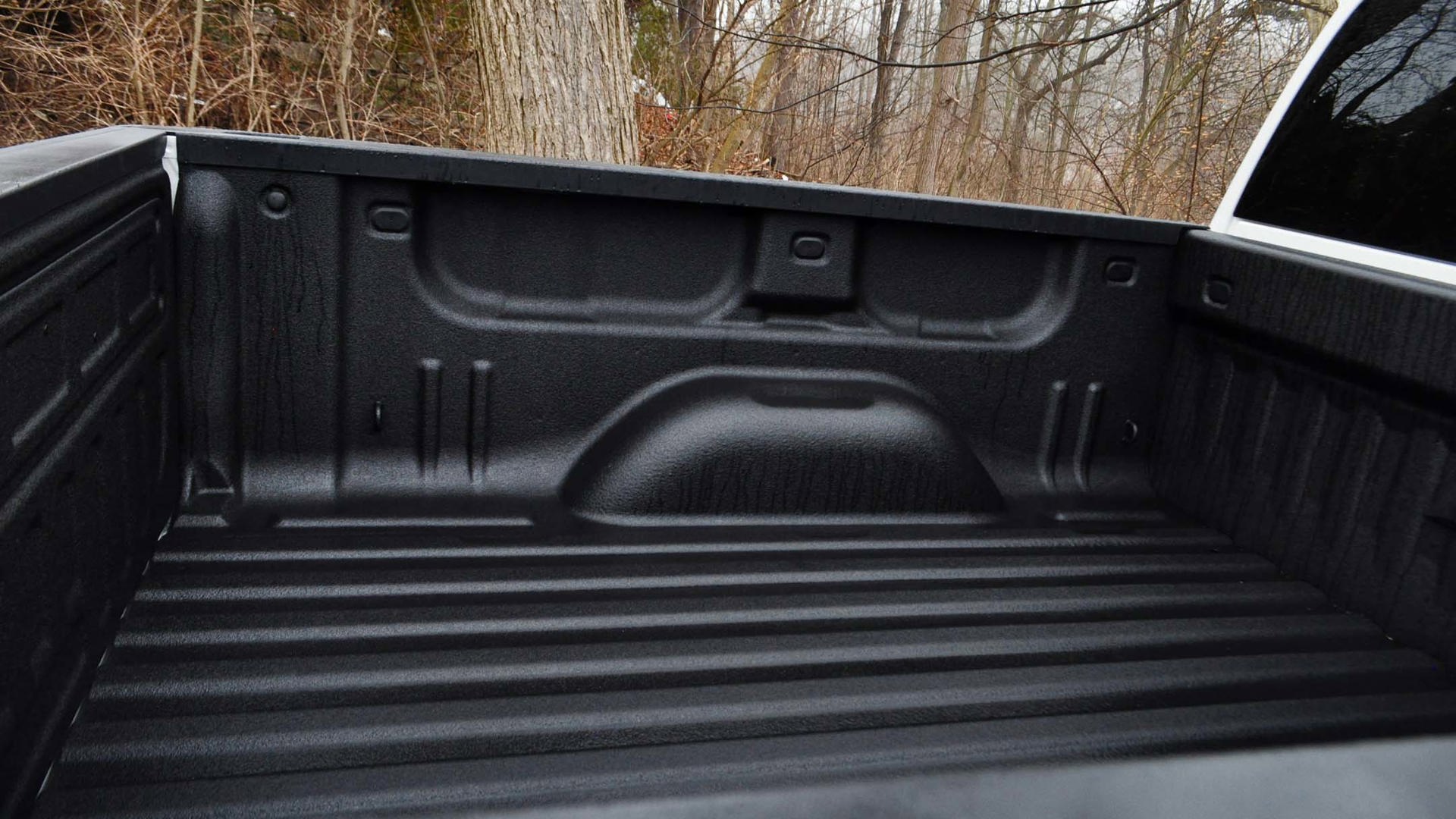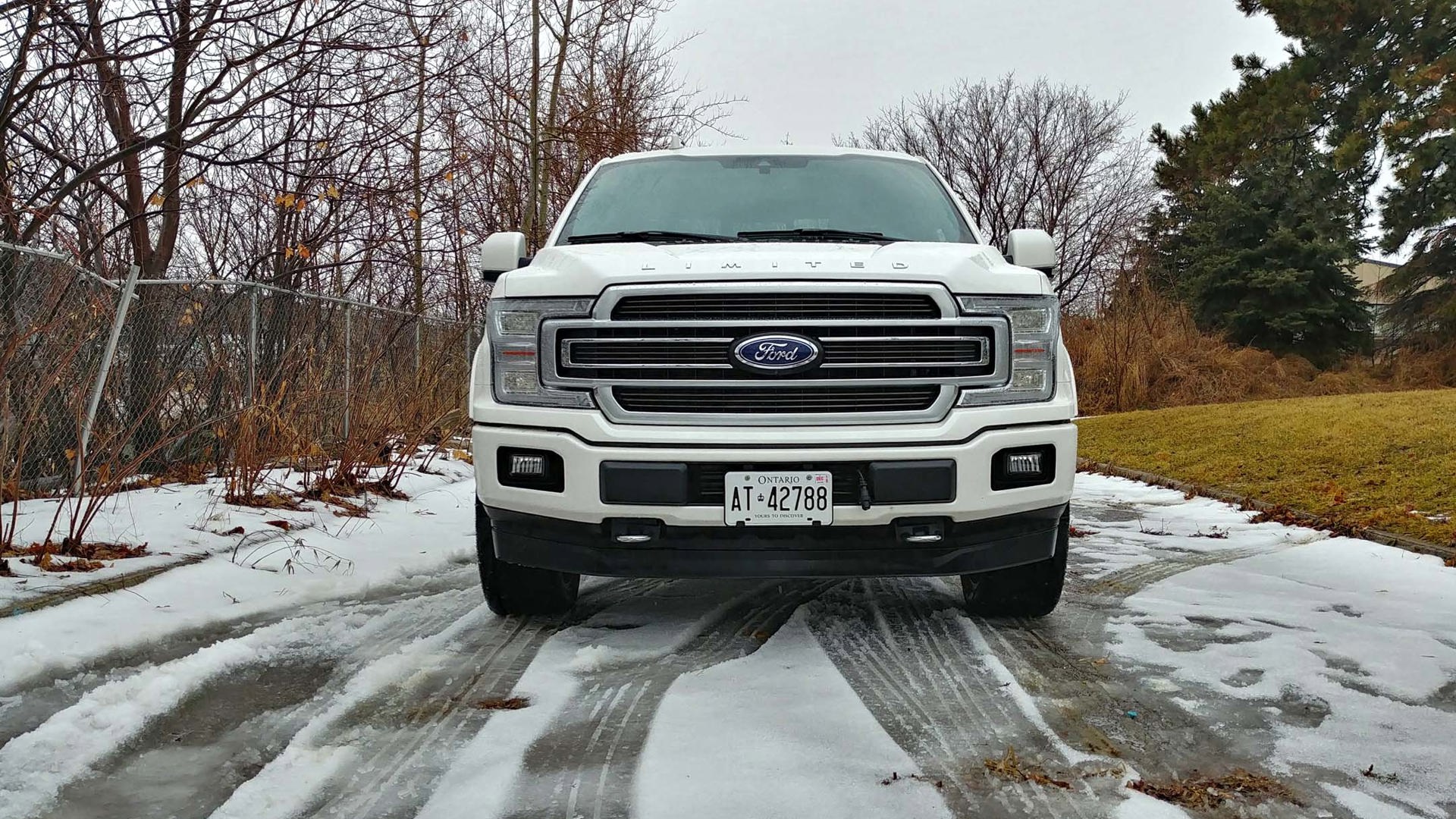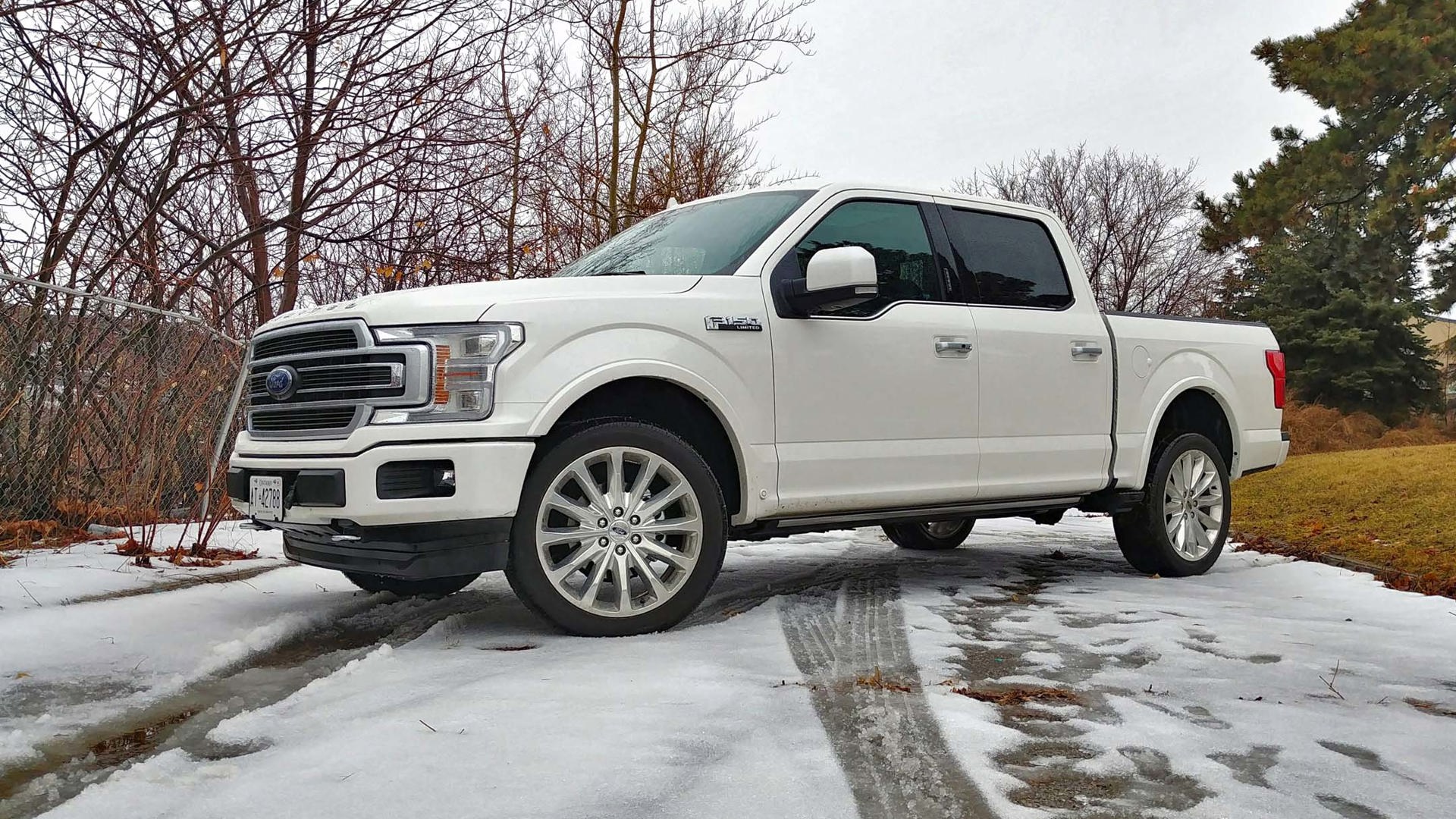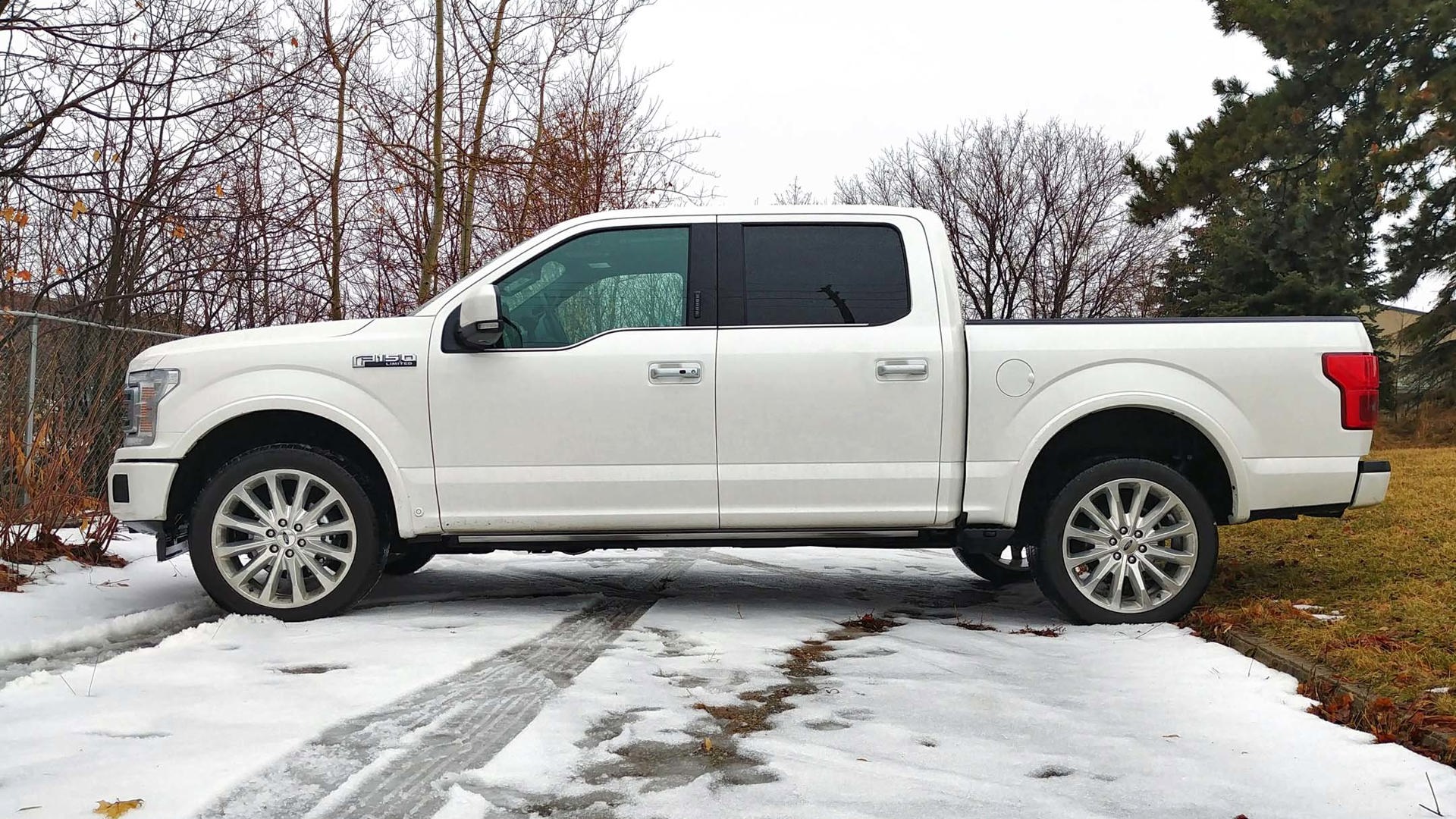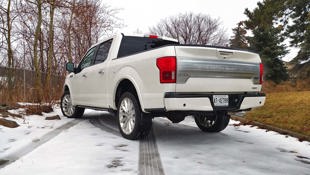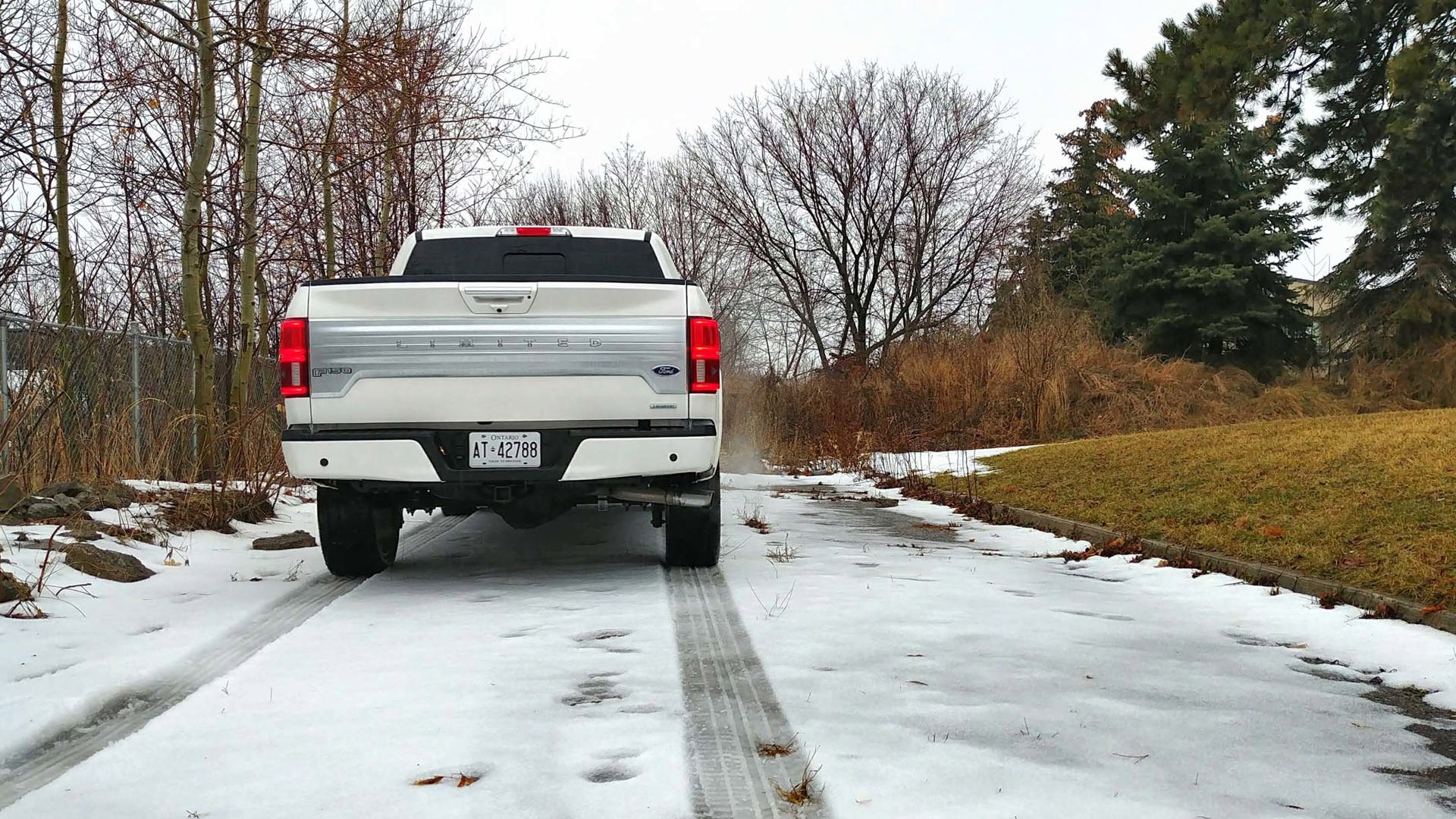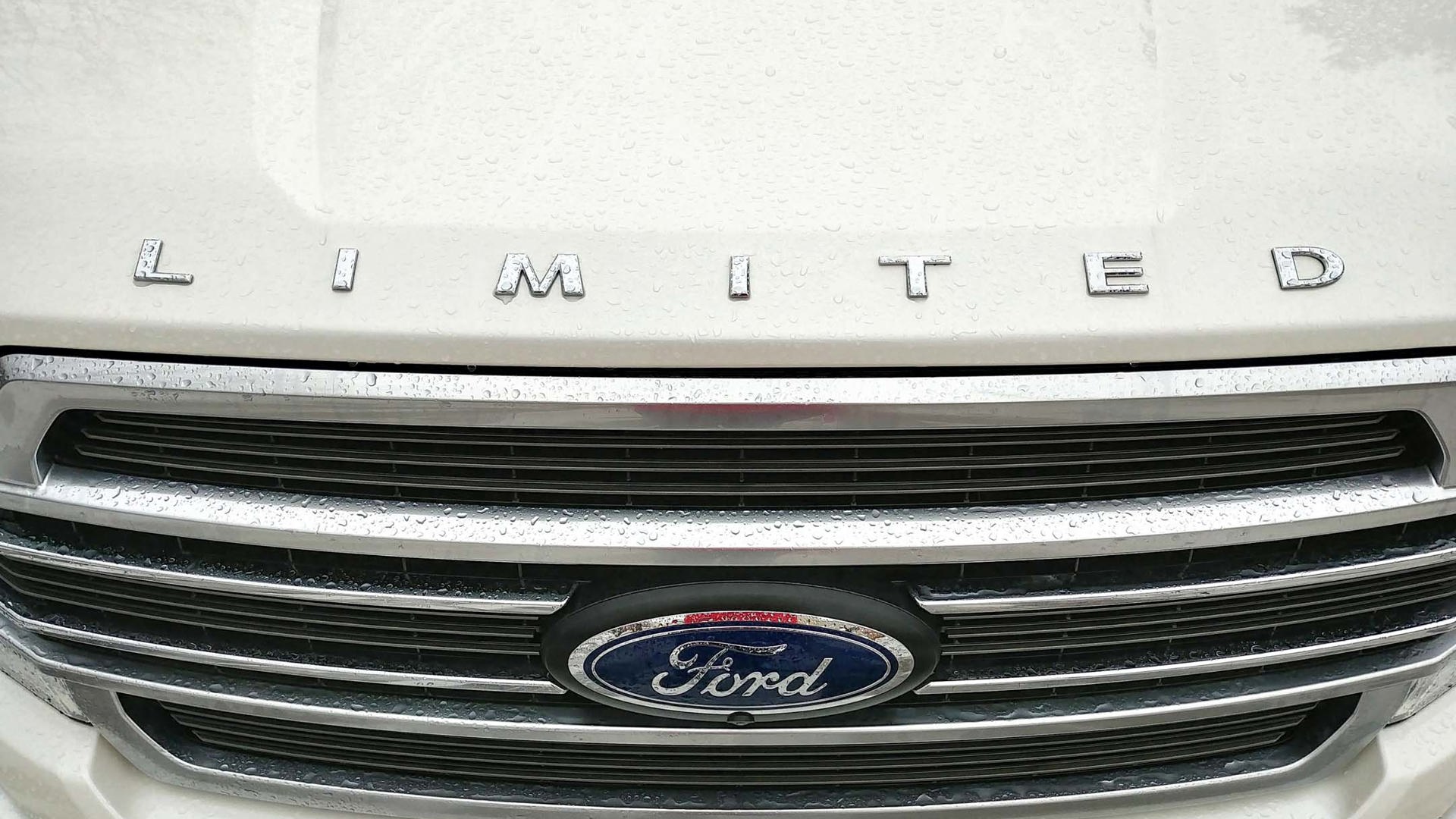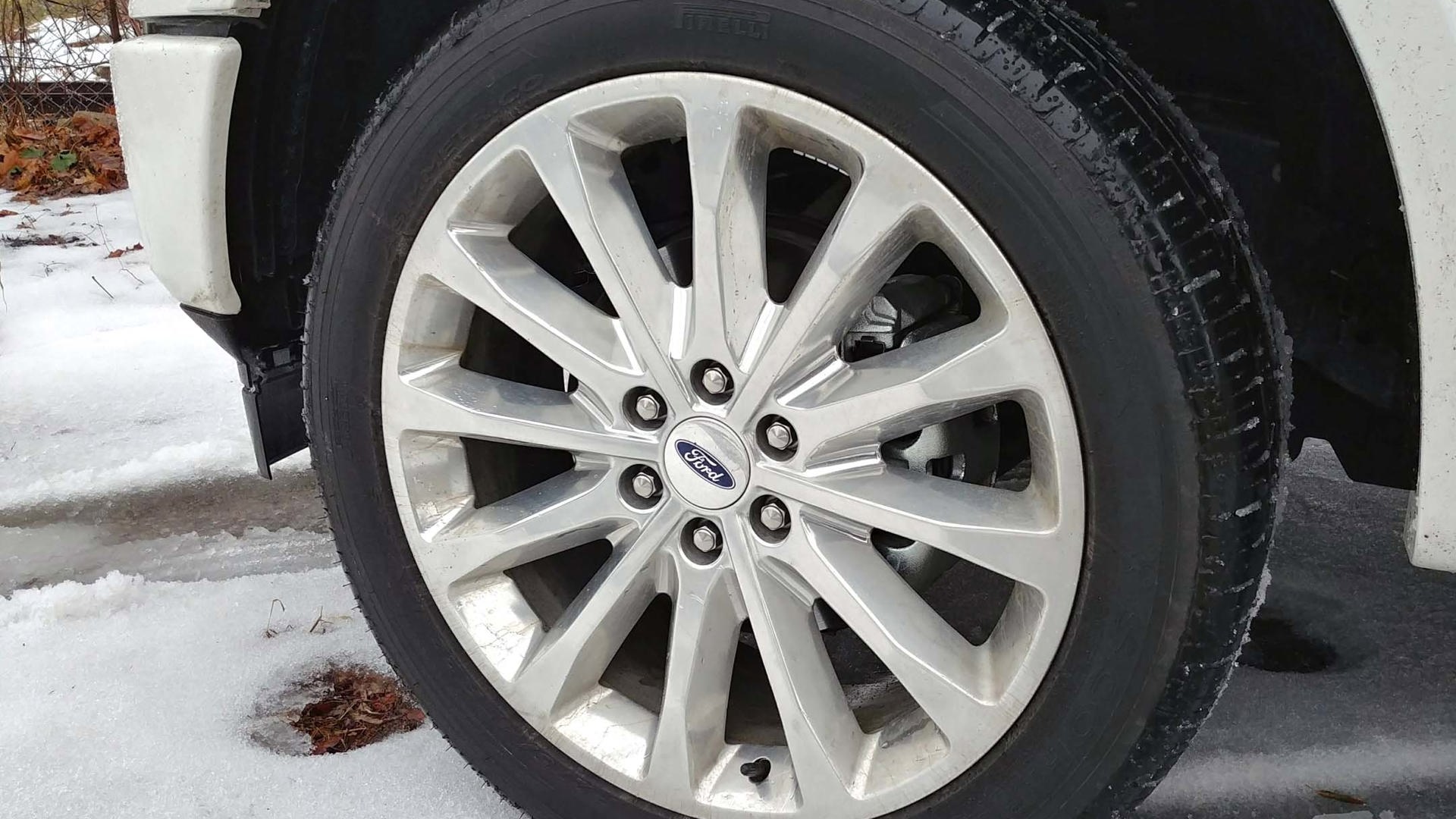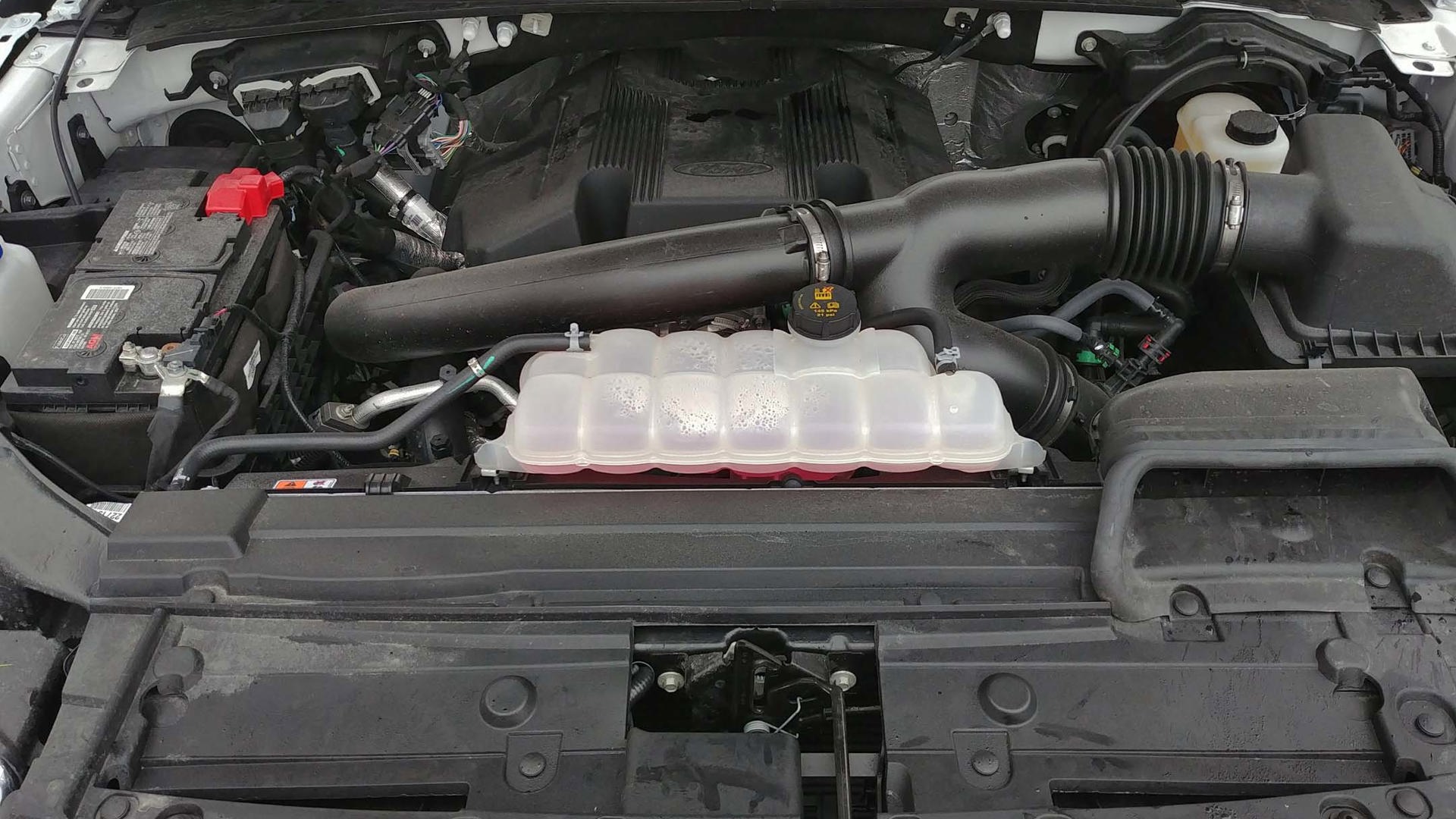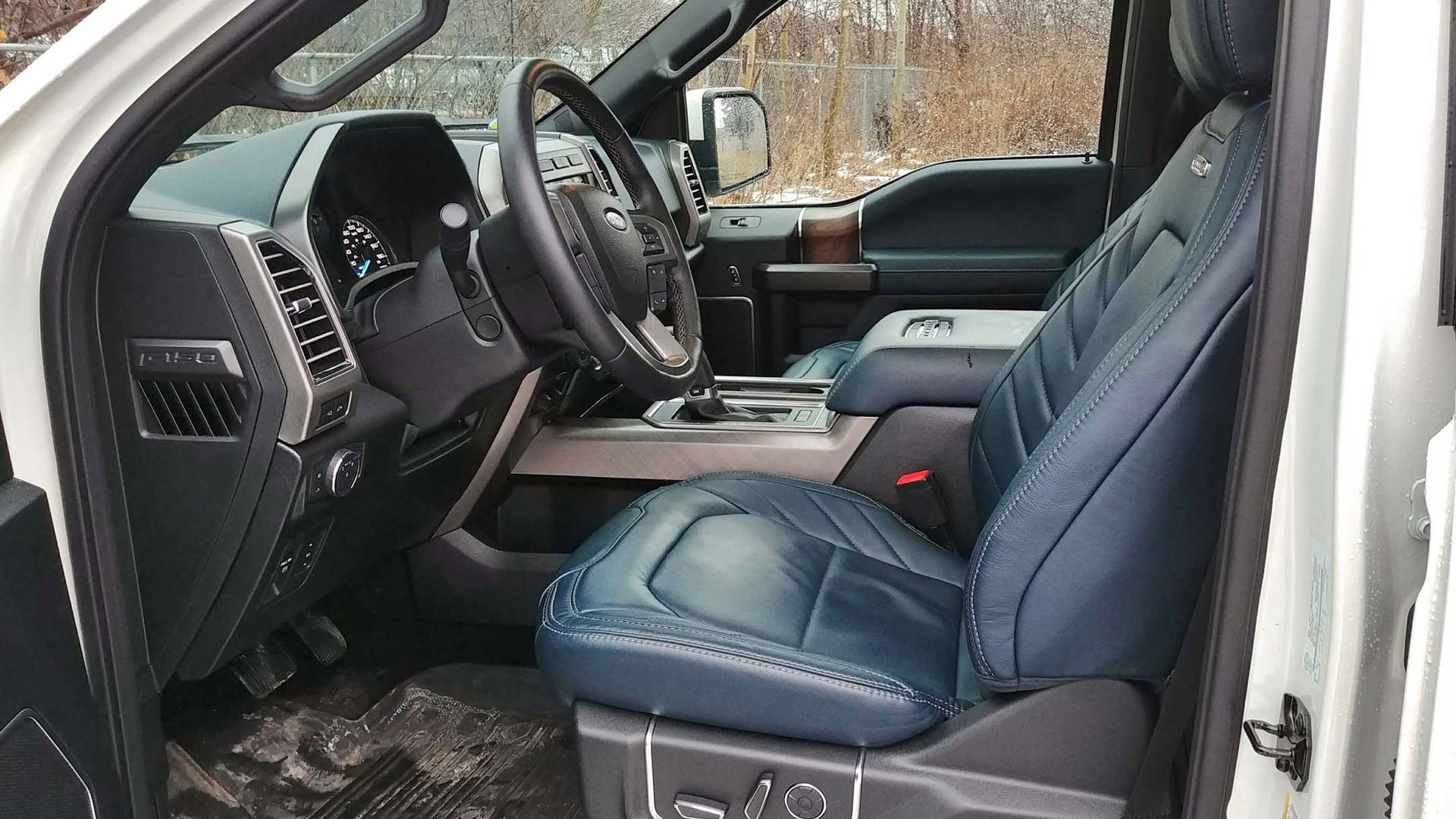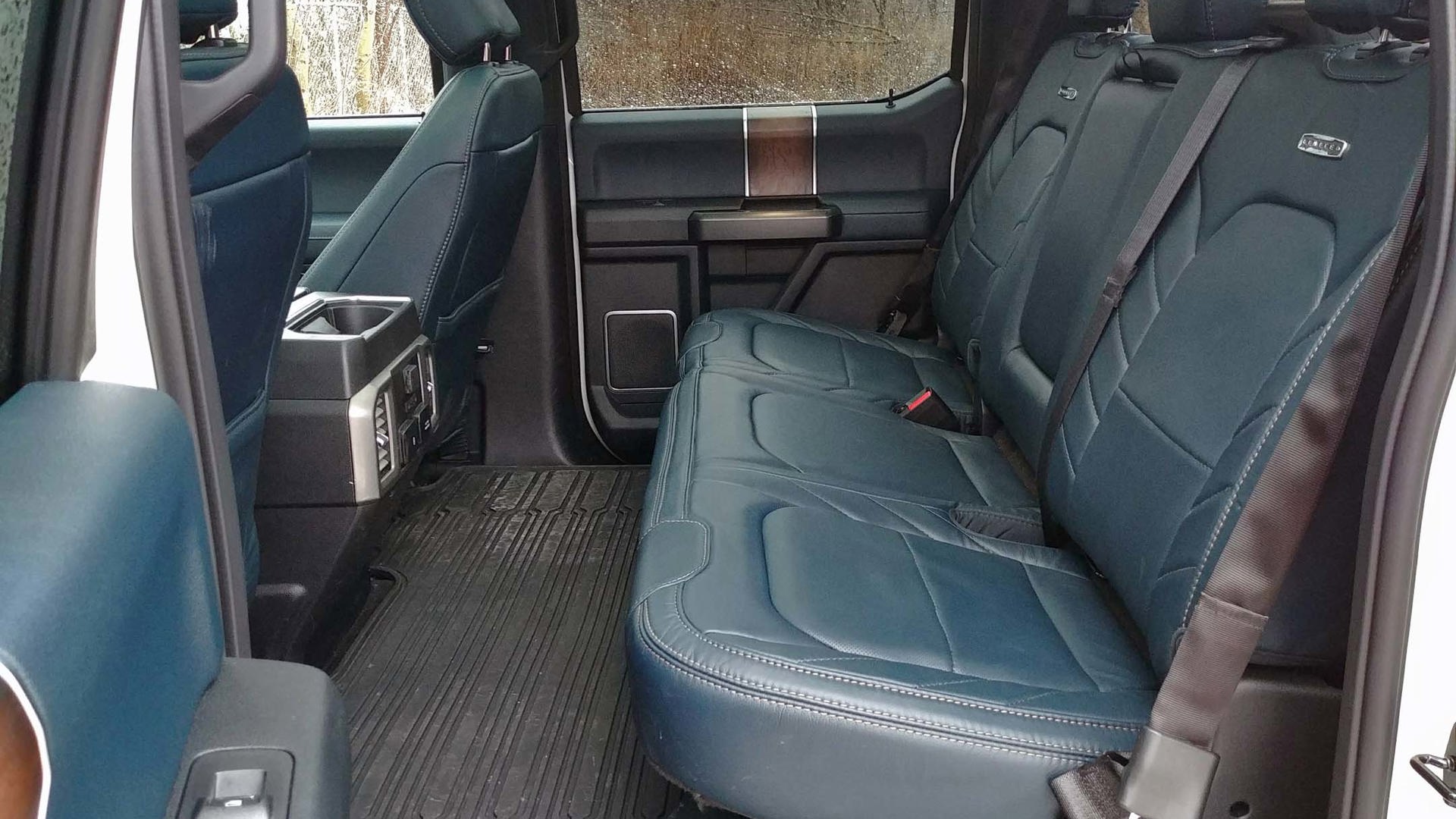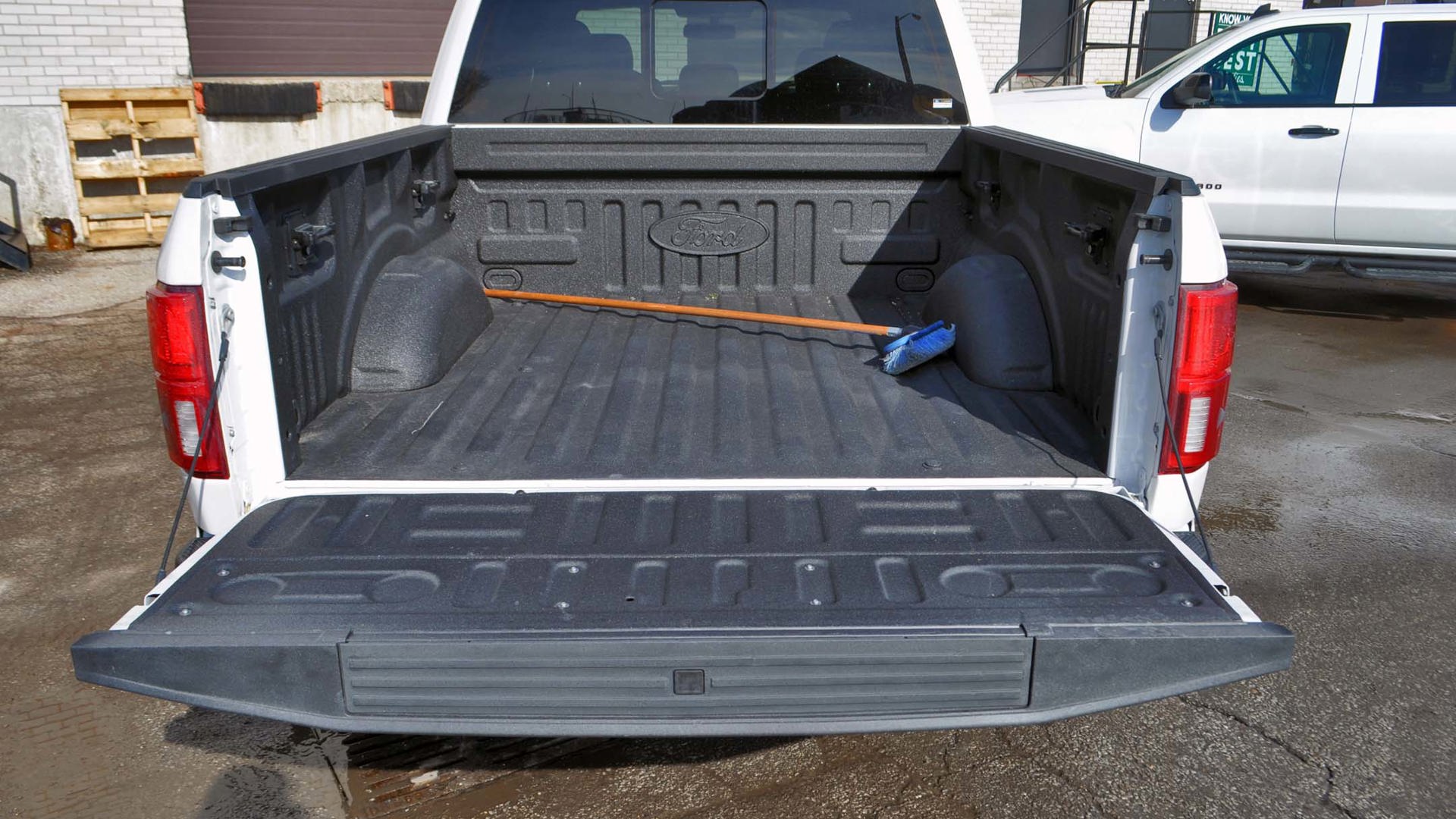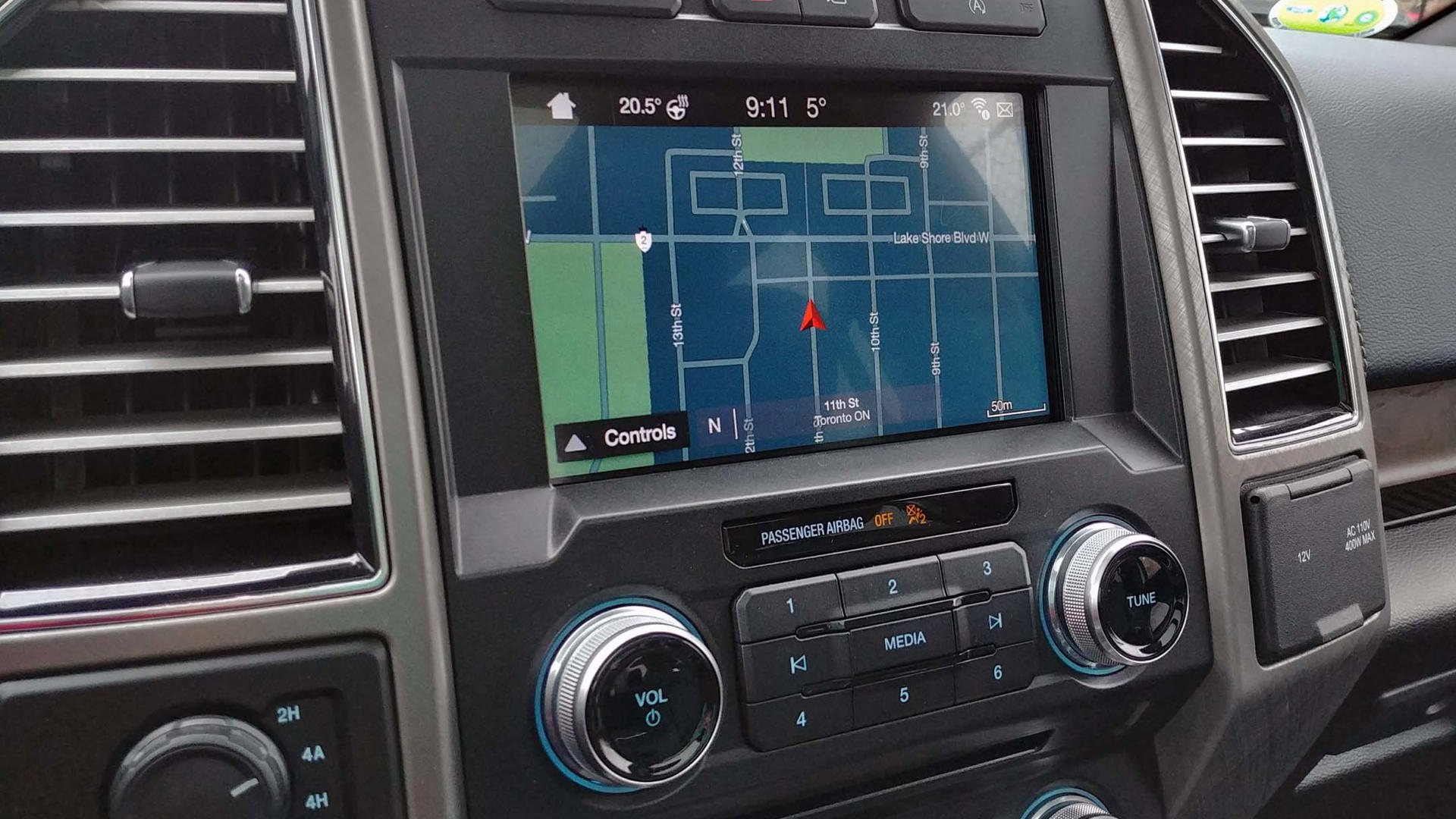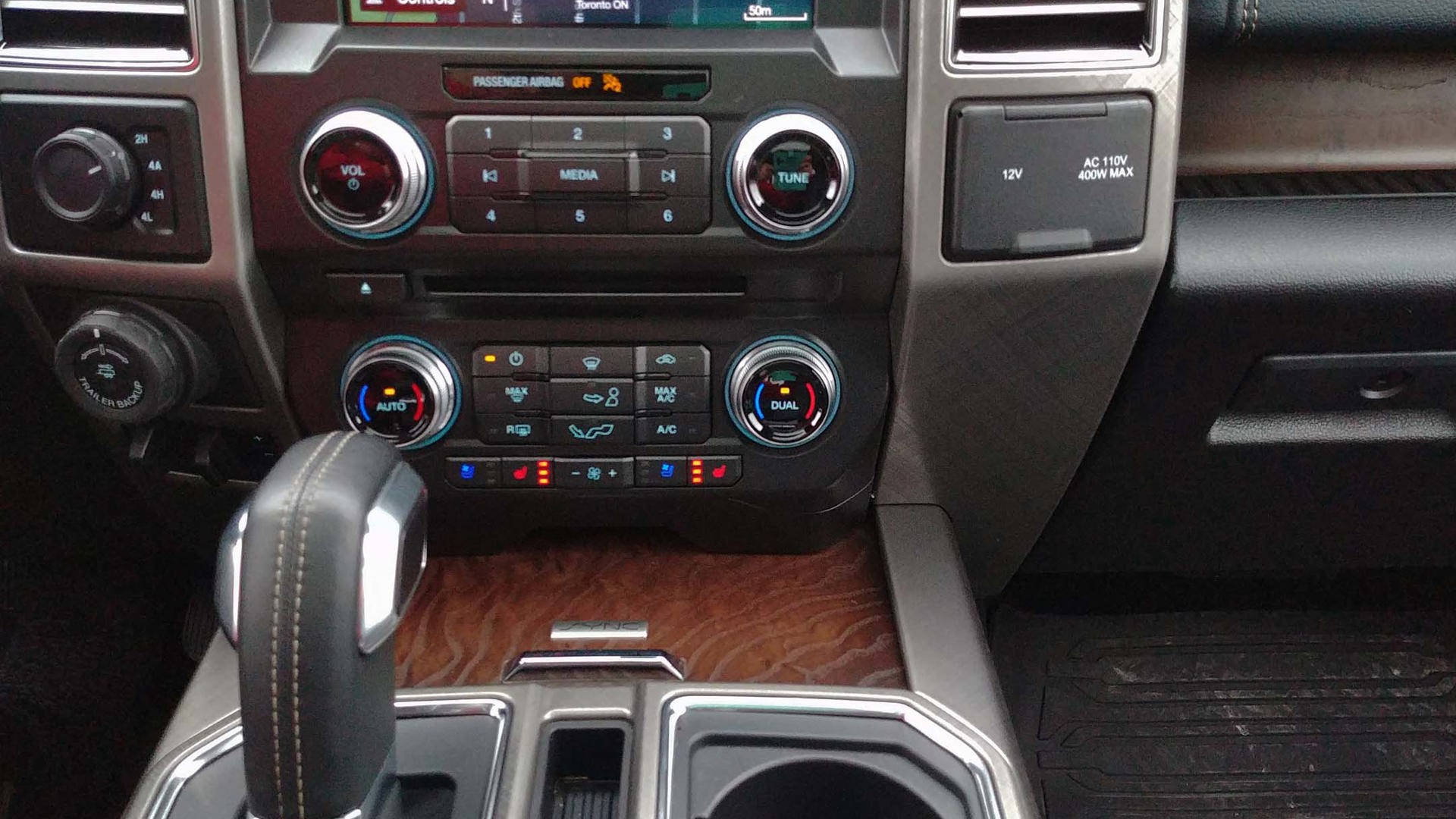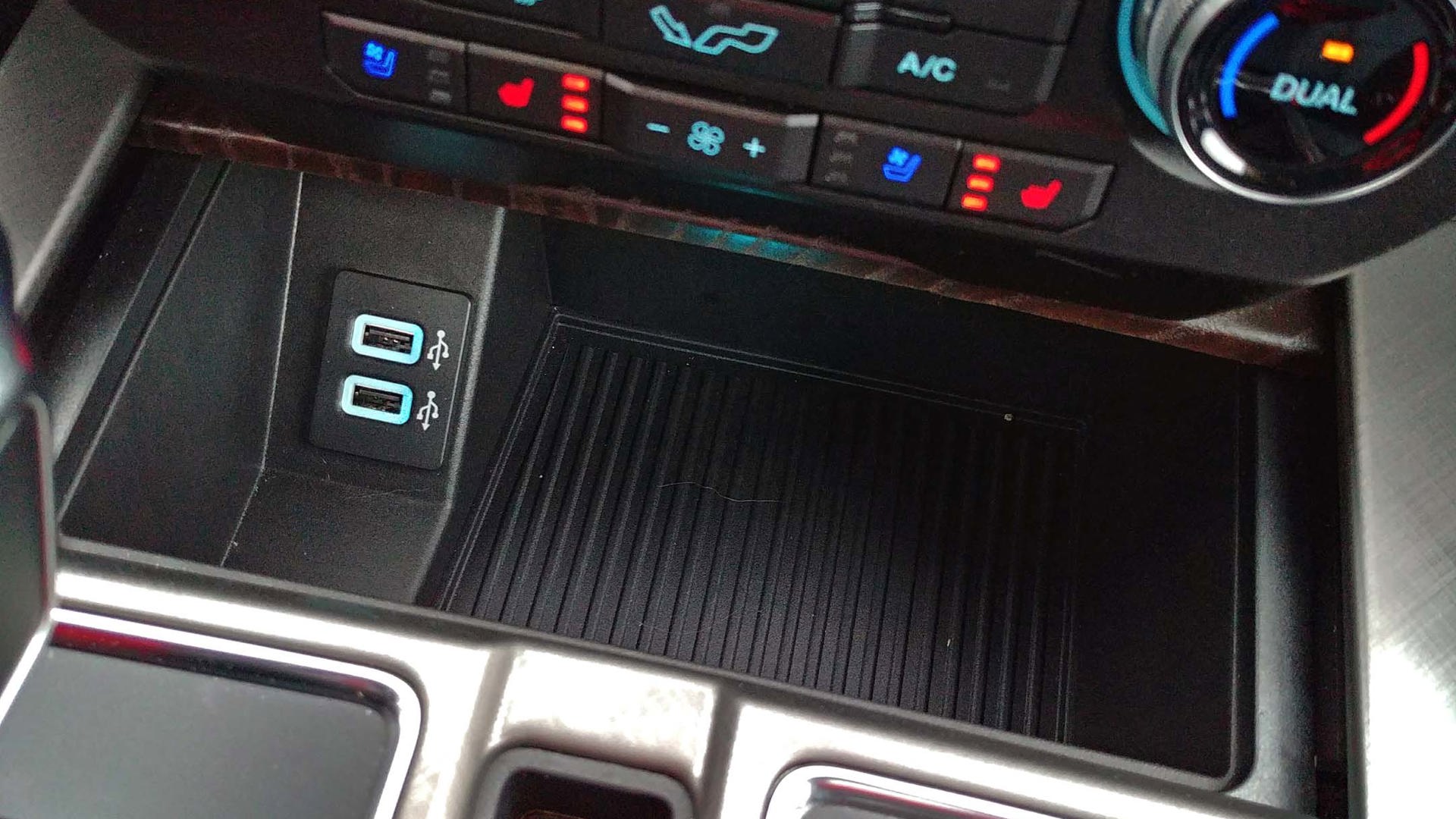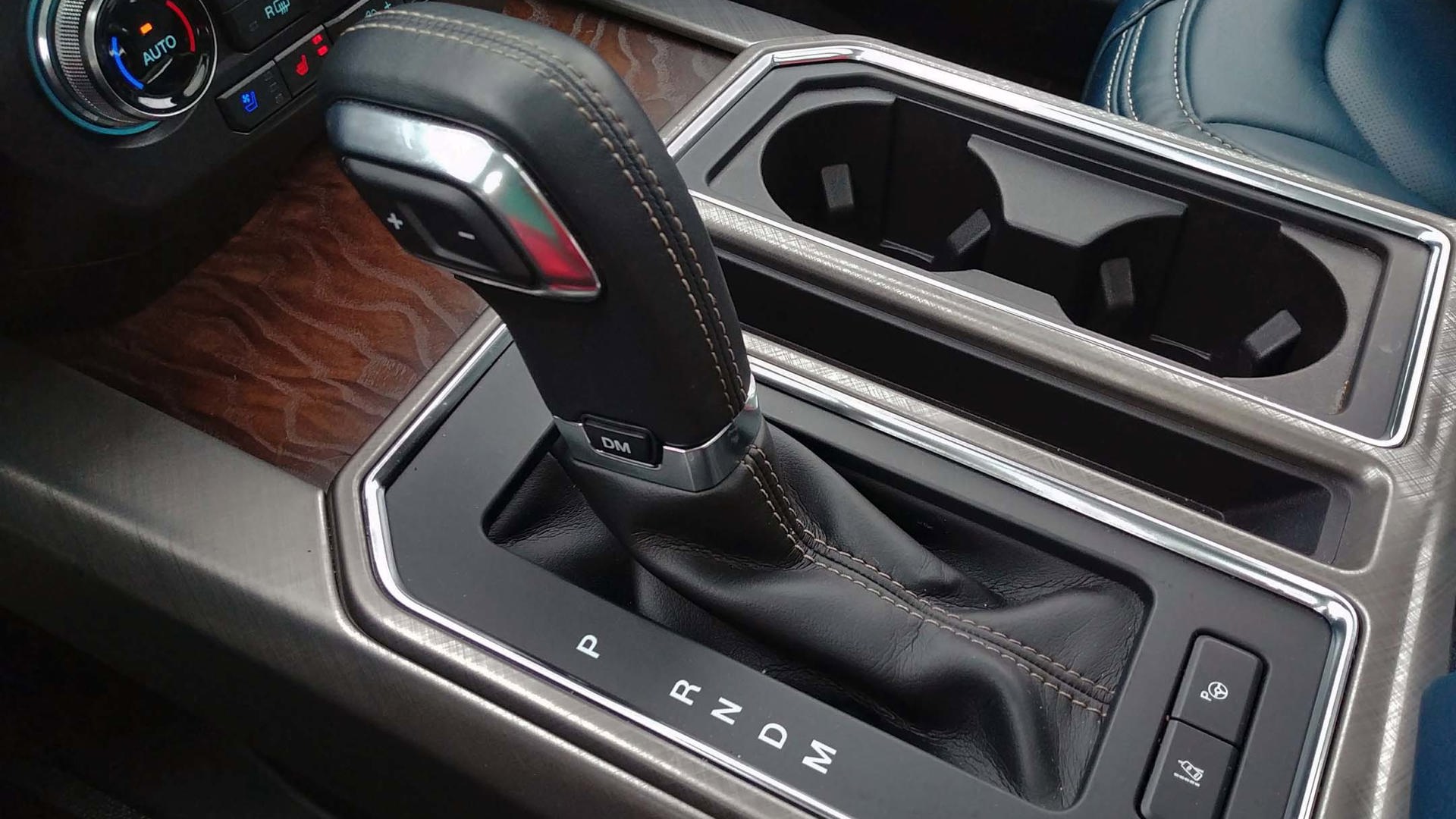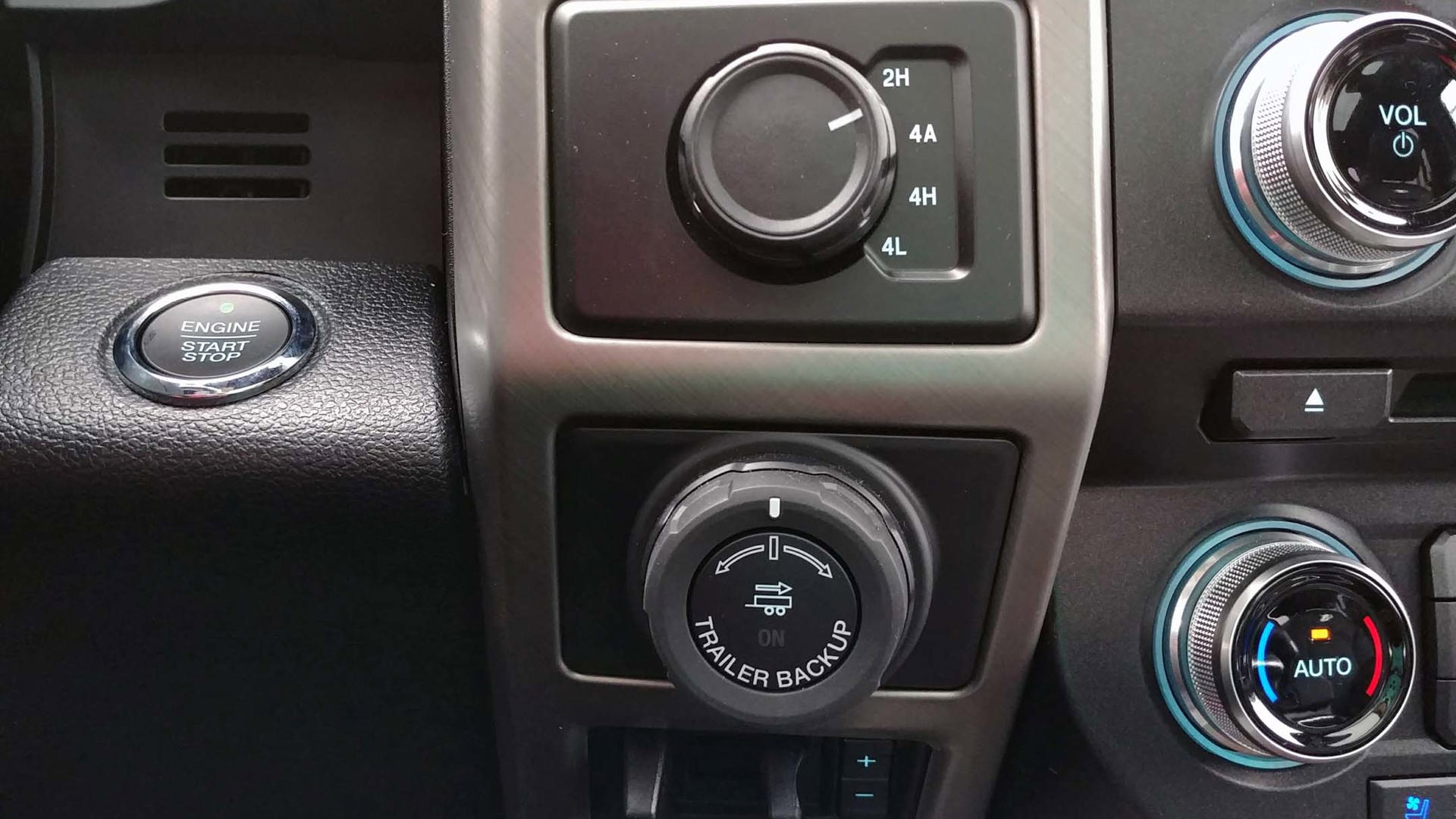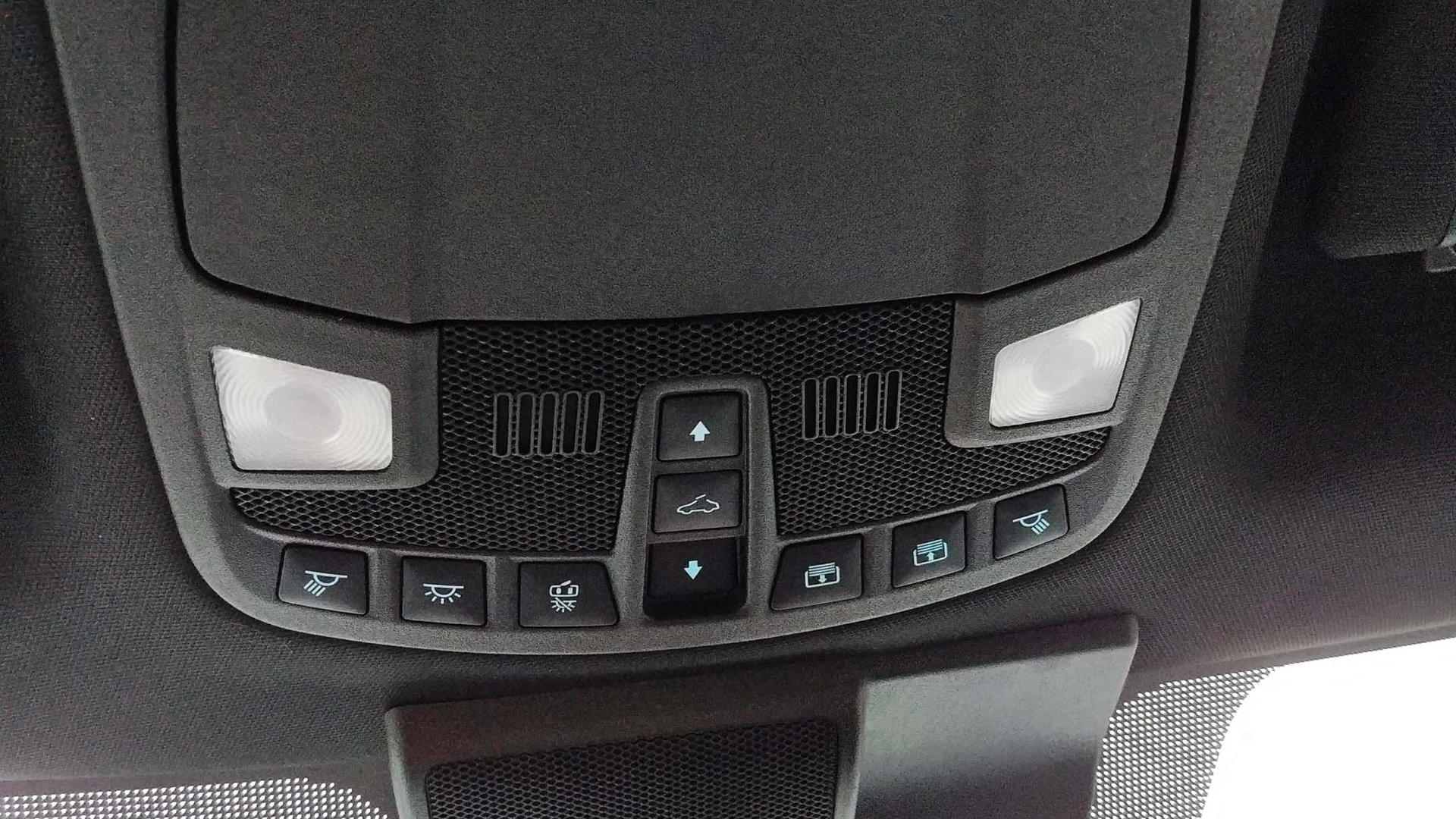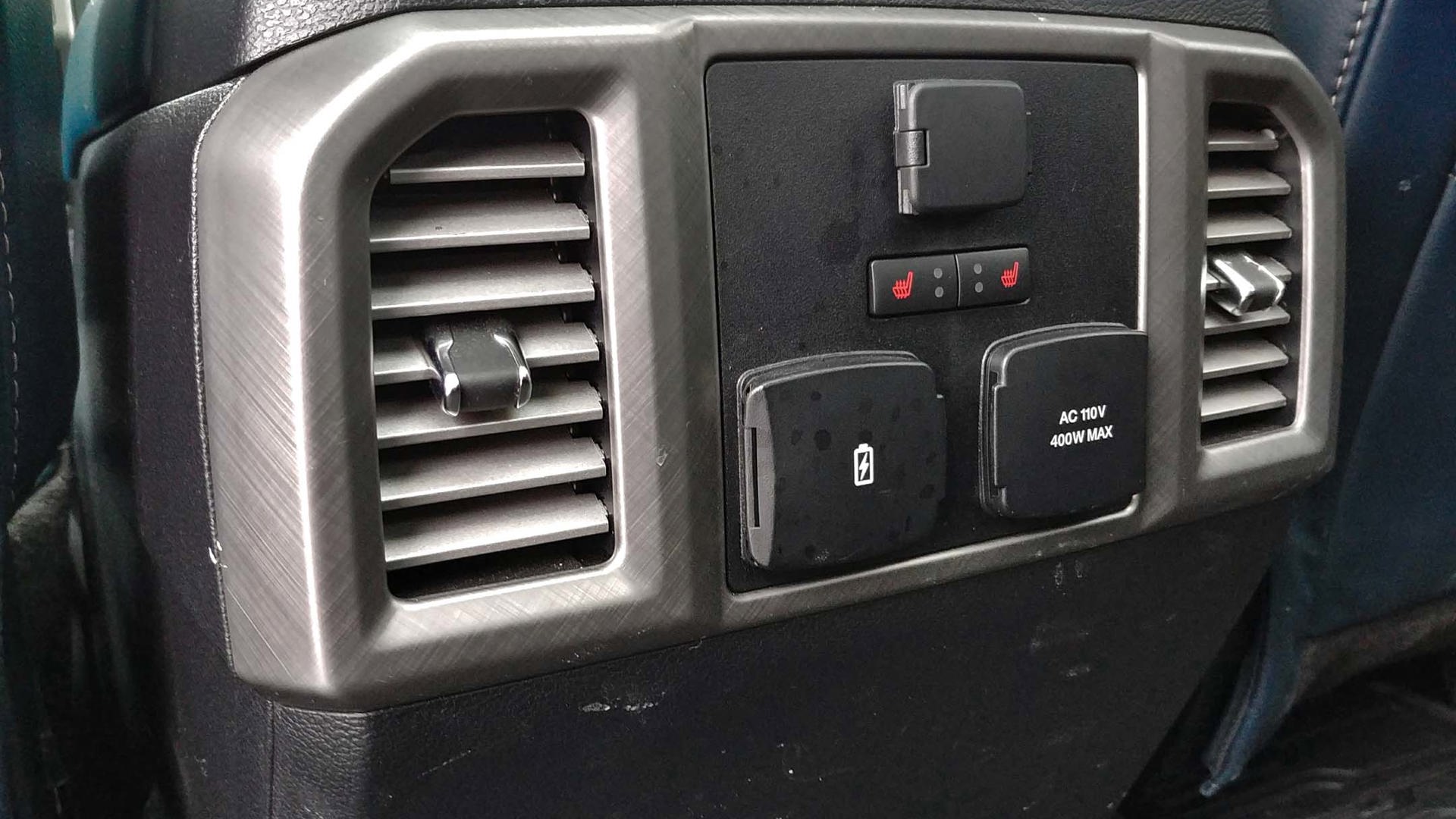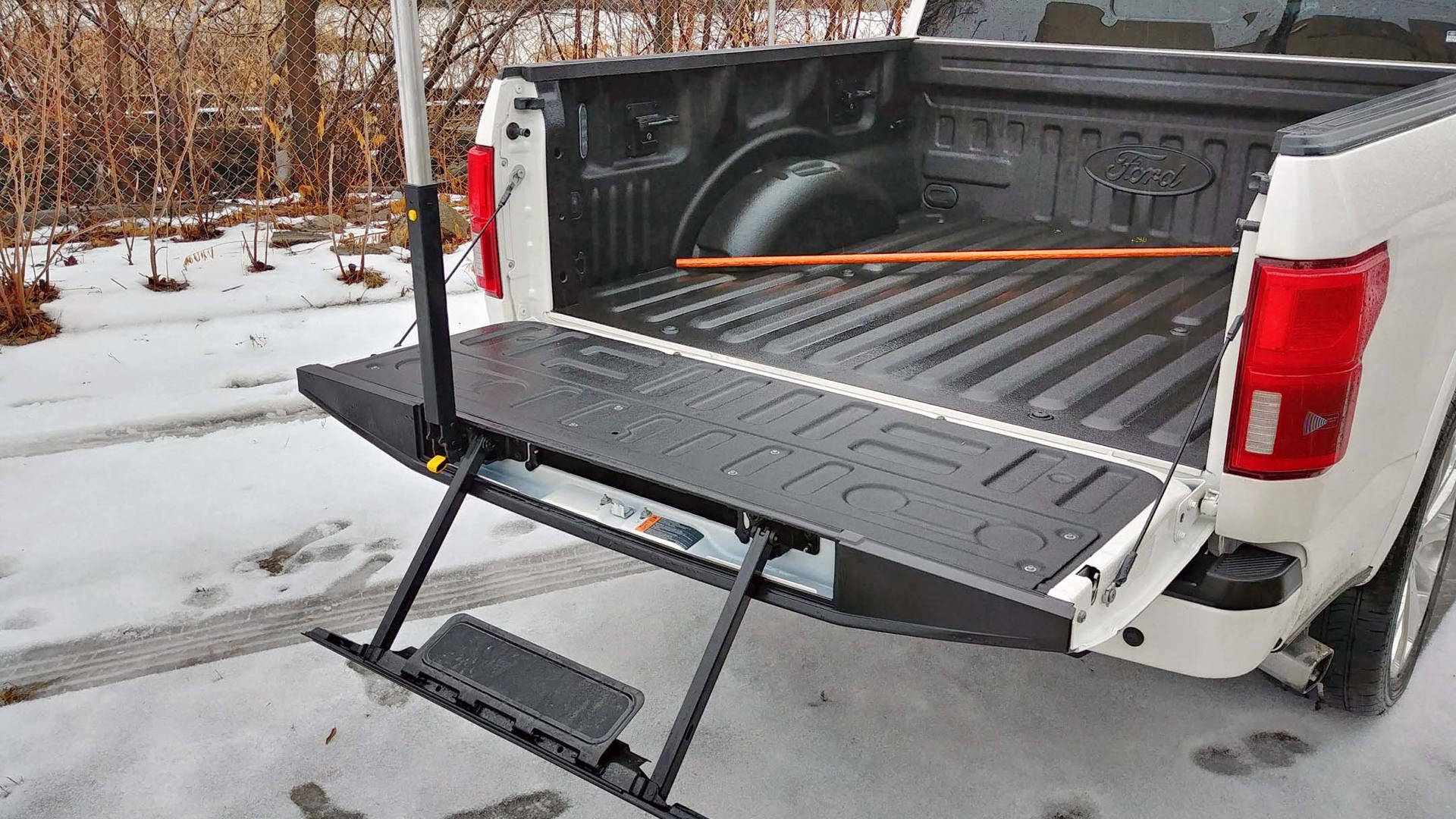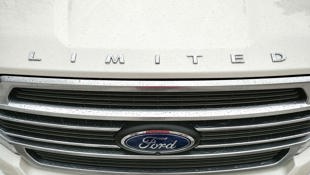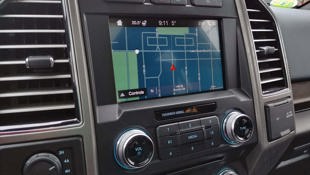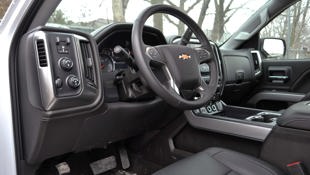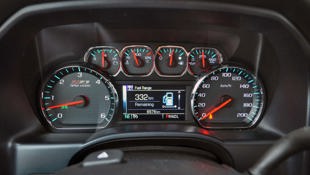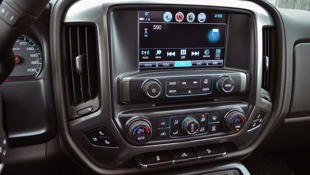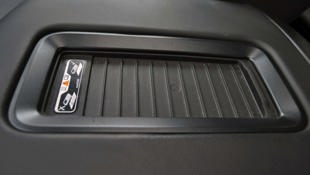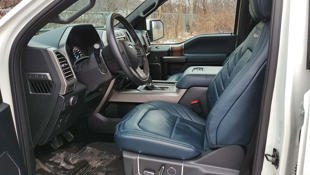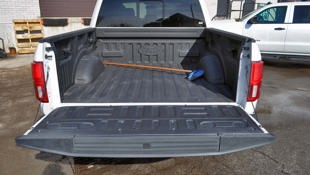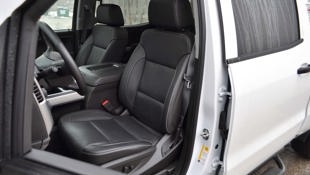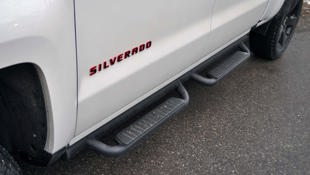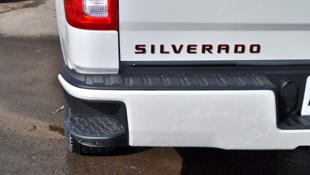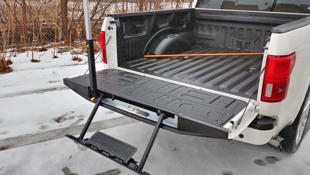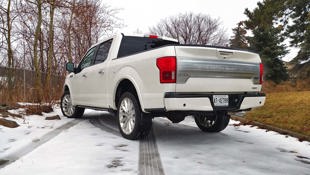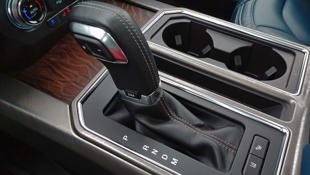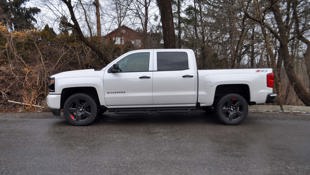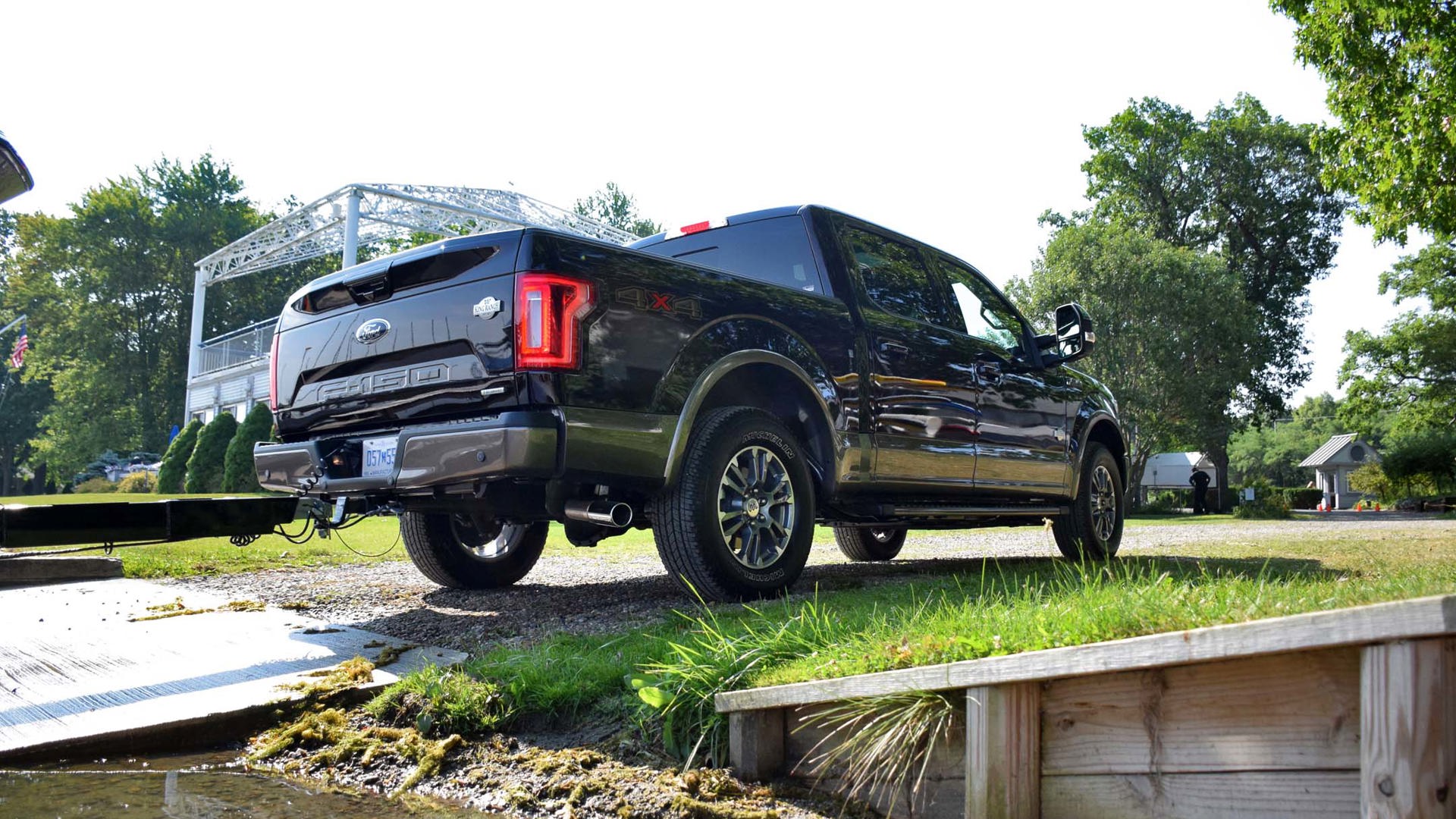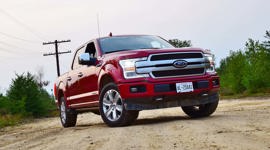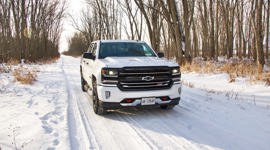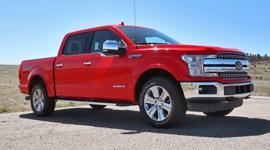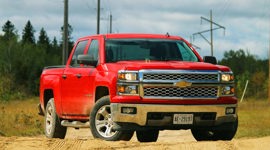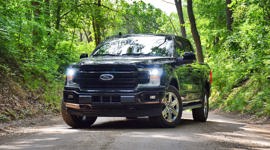Comparison Data
|
2018 Chevrolet Silverado 1500
|
2018 Ford F-150
|
|---|---|
|
Engine Displacement
5.3L
|
3.5L
|
|
Engine Cylinders
V8
|
V6
|
|
Peak Horsepower
355 hp
|
375 hp
|
|
Peak Torque
383 lb-ft
|
470 lb-ft
|
|
Fuel Economy
15.6/11.6/13.8 L/100 km city/hwy/cmb
|
14.4/10.6/12.7 L/100 km city/hwy/cmb
|
|
Cargo Space
1,700 mm bed
|
1,704 mm bed
|
|
Base Price
$56,725
|
$77,779
|
|
A/C Tax
$100
|
$100
|
|
Destination Fee
$1,700
|
$1,800
|
|
Price as Tested
$66,775
|
$81,749
|
|
Optional Equipment
$8,250 – 2LZ Z71 Off Road Package $2,845; Redline Edition $1,325; Iridescent Pearl Tricoat $1,195; Full Feature Front Bucket Seats, incl. Wireless Charging $845; MyLink Audio w/ Navigation $795; Heated & Ventilated Front Seats $745; Trailer Brake Controller $350; LED Cargo Box Lighting $150
|
$2,070 – White Platinum Metallic Tri-Coat $550; Box Side Steps $500; Spray-In Bed Liner $550; Skid Plates $120; All-Weather Floor Mats $170; Wheel Well Liner $180
|
If true American grit is measured in payload and towing capacity, there’s nothing wrong with indulging in a bit of luxury, where top-of-the-line pick-up trucks come to play. We decided to put two well-to-fully optioned full-size pick-ups up against one another in this comparison test of 4x4 goliaths, of both size and sales.
With an all-new 2019 Silverado coming this fall, this will (likely) be the final faceoff between these two particular pick-up powerhouses.
For this throwdown, autoTRADER.ca managing editor Michael Bettencourt and I set out on a mission to determine which of the 2018 Chevrolet Silverado and the new Ford F-150 is the best all-around pick-up truck, especially for folk who drive in the city often, which is clearly not the natural habitat for these behemoths.
With an all-new 2019 Silverado coming this fall, this will (likely) be the final faceoff between these two particular pick-up powerhouses. And a useful rundown for folks eyeing the likely juicy deals on outgoing ’18 models once the ’19s start arriving en masse.
Something old, something new
For 2018, the aging Silverado is measuring up to the newly updated Ford F-150 that’s received a laundry list of upgrades, including a new EcoBoost engine, the 2.7L V6, and an enhanced towing capacity that now flirts with the 6,000 kg mark.
The bowtie truck received a mid-cycle refresh in 2016 and with a full overhaul already revealed, it carries over from the previous years with little to no changes.
Both designs are a variation on the same theme: a rectangular grille with muscular lines. The result is more successful on the Ford. The flat-nosed Silverado lacks a bit of dimension to really be handsome.
The new Ford design is an evolution of the lines introduced in 2015 with the U-shaped headlights, gaining in refinement and, in the Limited trim’s case, in chrome. The half-moon grille has been reworked and now resembles more a belt buckle, integrating the headlights design to the ensemble.
“Both clad in white, the F-150 is more the good but traditional cowboy compared to the Chevy,” said Michael. “The F-150’s high-end LED headlights make it stand out more at night than in daylight.”
We got to test drive both models fully decked out with a full-size crew cab. This 2018 Silverado Z71 1500 4WD LTZ Crew Cab is priced at $66,775, with options such as underbody shield, hill-descent control, and trailer brake controller. The version we tested was equipped with the Z71 Off-road and Redline packages.
Michael noted: “The red calipers and tow hook accents up front, plus the black wheels and Chevy bowtie that come with this Redline Edition makes it the more visually aggressive of the two, but not in an outlandish way.”
Its Ford counterpart, the fully decked out F-150 4x4 Limited with optional features including skid plates and spray-in bed liner, came in at a hefty $81,749.
We received both models clad in a white pearlescent paint job, a $500 option at Ford’s, priced at $1,195 at Chevy’s. Beauty comes at a cost, though dirt appeared painfully quickly on both.
Considering the price gap between our two testers, I did some research into lower-priced F-150s out of curiosity to see just how much of a difference $15,000 made. I found the F-150 King Ranch to be priced closer to this Silverado.
Granted, the King Ranch loses some of the standard features that make the Limited version so convenient, such as the power running boards, the tailgate steps, and the 360-degree camera. But they all remain available options, should you really miss them. The standard engine for the King Ranch is the naturally aspirated 5.0-litre V8 rather than the EcoBoost, again, offered as an option.
Bottom line, the difference between the $66K and $81K F-150 pretty much comes down to standard versus optional equipment, which at least gives the customer a chance to decide what’s worth their money and what isn’t.
Interiors worlds apart
I find the two interiors to be worlds apart and comparing them is like putting Justin Bieber up against Beyoncé in a musical talent show – wildly unfair. The cabin in the Silverado sadly is what I expect from a Chevy: efficient, but cheap-looking. I say sadly because the materials are surprisingly basic for the price point. Plain plastic surfaces and plastic-feeling leather are a fair but failed attempt at luxury.
The Ford heavyweight better meets its price expectations. Don’t get me wrong, the F-150 isn’t clad in gold, fur, and carbon fibre – plastic is on the menu here as well – however, the treatment gives it a higher-end feel. The leather is a lot softer, with some nice contrasting stitching, and accompanied by real wood appliques.
Where the Silverado receives points is for its interior layout. The Ford has a massive and well-garnished centre stack with all the climate and multimedia controls, the trailer assist knob and a standard if oversized gear shift.
The Chevrolet’s gear selector, meanwhile, has been replaced with a column-mounted lever, creating some additional storage in the centre console. The trailer braking module is located on the left-hand side of the steering wheel which makes the centre stack a lot less button-heavy. Wheel-mounted multimedia controls are located at the back of the Chevy’s steering wheel, using the entire space available rather than stacking and cramming all the controls in the same place.
As for the habitable space, despite the typically large console and armrest separating the front seats and the metre-wide legroom at the back, the interior of the Silverado felt more like an SUV to me.
Far from being tight, the Silverado’s cabin felt a lot cozier than the F-150’s. The latter almost felt too big. Have you ever felt the vast emptiness of space? That’s what the F-150 feels like, especially at the back. The front is crowded with the dashboard, controls, and such, but the back is a big, huge, empty space.
Not that there is anything wrong with vastness, but legroom in the Ford is a ginormous 1,107 mm. The bench can even be lifted up, which is extremely helpful for hauling stuff you don’t want exposed to the elements in the box. I jokingly told some friends that I could fit a single mattress in the back and just live in the truck for a few days. Had it not been winter, I seriously would have considered it.
“Space inside the Ford is massive, especially in the rear seat – mischievous adults would have trouble kicking the front seats, let alone kids,” said Michael. “It has been clearly designed to offer roomy accommodations for tall and burly types all around.”
Chevrolet much cheaper, but not absolute value winner
In terms of equipment, it once again feels like an unfair battle. Though I understand that when it comes to pick-up trucks utility is the main focus, how do you justify paying $66,000-plus for a truck with a turn-key ignition?
When you consider that most of the brand’s entry-level models offer a proper keyless proximity-access and push-button start system at a much lower price, how can the Silverado force you to rummage through your pocket – or in my case, my Mary Poppins purse – to find the key?
Both Michael and I scratched our heads over this decision by GM. “If a $20K Corolla has keyless access, there’s no reason for a $66K Chevy pick-up truck not to.” However, he did add that since you have to dig the key out to unlock the vehicle anyway, chances are you still have the key in your hand to start the engine. So there’s that.
This isn’t an issue in the F-150, which one-ups the Chevrolet in other regards as well. While both provide similar equipment in terms of comfort, utility, and entertainment, the Ford adds a few thoughtful touches, including a 110V outlet and heated seats for the rear passengers, as well as the brand-exclusive Pro Trailer Back-up Assist, which eliminates the disorienting mirror effect of trying to back up with a trailer hitched.
Comparable access and practicality
Access to both giants could be a daunting process were it not for the presence of practical side steps that makes access onboard a lot more elegant than it could be without. Ford ups the sidestep ante with a set of powered boards that unfold when the doors open, like a welcoming hand helping you in and out.
“The powered side steps are the expensive but best way to do truck steps: normally up and free from the elements, they lower when the door opens, minimizing any snow or ice buildup on them,” said Michael. “Plus they extend all the way to the back, which provides a bit more security than the individual steps on the Chevy.”
In the box, both models provide multiple anchor points as well as convenient steps to help reach into the back. Chevy adds a practical cargo box lighting system and clever footholds integrated into the rear bumper corners, whereas the Ford offers a tailgate-mounted retractable step to easily get in and out of the bed, complete with an extendable steadying grab bar.
Payload is rated at up to 912 kg for Silverado, and at up to 925 kg for the Ford in the versions we tested.
Power and handling – sort of
Low-profile tires are an easy and not-too-expensive way to give your ride a little more spirit on the road. But on a pick-up truck? They make you look like a poser. The F-150 Limited is equipped with 22-inch wheels, fitted with a set of P275/45R all-season tires which distorted the ride quality in my opinion. I found myself in a weird place where the suspension felt perfectly comfortable, even slightly bouncy, but I could feel every imperfection in the road to my core. At least they looked good.
The suspension on the Silverado is slightly stiffer, which I personally prefer. I didn’t feel completely disconnected from the road and it made the vehicle feel a little more agile. No low-profiles on this beast, which received instead a set of all-terrain rubber mounted on 20-inch wheels.
We disagreed on the riding comfort and the handling, Michael preferring the Ford over the Chevy, he admitted that there were some admirable qualities to the Silverado. “No pick-up can be called a handler, outside of the Raptor (maybe), but it’s fairly competent in corners – not totally flat, but less body lean than a vehicle this tall has any right to lean.”
The Chevy felt more archaic to him: “It feels like an old platform spruced up – there’s still notable brake dive and squat when driving normally, plus relatively raucous engine noise coming from the direct-injection V8.”
Braking is no laughing matter when driving a two-ton pick-up truck. Braking in the Ford is all about anticipation. The pedal is mushy under the foot and the braking is so gradual that trying to bring the rig to a smooth halt is a challenge, forcing you to push the pedal all the way in and give your passengers a scare, especially in rush-hour traffic.
Braking is a lot more linear in the Silverado. The pedal is firmer and the response is instant, which allowed me to feel more in control.
The taller Z71 off-road package likely contributes to this feeling, with its 46 mm Rancho monotube shocks, though it does also come with a 36 mm front stabilizer bar to counteract the higher centre of gravity.
The Chevrolet Silverado is equipped with a 5.3L EcoTec V8 engine rated at 355 horsepower and 383 lb-ft of torque. The Ford F-150 sports a smaller block with the 3.5L EcoBoost V6 engine, but with a bigger output with 375 horsepower and 470 lb-ft of torque. Despite the difference in numbers, both powertrains felt sufficient for the size of the vehicles and power was readily available. And in case you want to put your luxury pick-up truck to good use, the V8 can haul up to 5,443 kg, and the V6 EcoBoost up to 5,761 kg.
The Z71’s V8 sounds slightly less refined than the EcoBoost and I found there was some significant lag with the eight-speed automatic transmission. Michael was less perturbed by the drivetrain, as he found the transmission did a good job at getting you the power you need in a timely fashion, but less impressed with its noise and higher fuel consumption.
What I did find impressive about the Chevrolet powertrain is the efficient cylinder-deactivation system that switches from four to eight cylinders depending on the need, whether you are cruising in town or accelerating on the highway. I found the switch between V4 and V8 very smooth and barely noticeable. Ford tackles fuel economy with a smaller turbocharged engine to reduce fuel consumption.
The makers’ efforts were not in vain since both models have managed to keep their fuel costs from amounting to a second mortgage. The Silverado ended our test loop at 15.7 L/100km and the Ford F-150, at 15.5 L/100km – surprisingly similar between the Chevy’s old-school V8 and the newer-school turbo six. Our city-centric driving over an entire week ended with the Silverado clocking in a whisker better overall at 15.9 L/100 km, with a basically equal 15.8 in real-world (winter) driving for the F-150’s 3.5L V6.
And both sadly nowhere near their NRCan ratings of 13.8 and 12.7 L/100 km, for the Silverado and F-150 respectively.
F-150 takes the win… for now
The Chevrolet Silverado and Ford F-150 are two of the fiercest competitors in the cutthroat pick-up truck segment. The F-150 really stood out as the more accomplished truck, even taking into account the significant price gap between the two versions tested. It’s not the refinement as much as the little details that make the F-150 the clear winner for me.
Whether it’s the easy access to the cabin or the box thanks to the integrated steps, the amount of storage, the features oriented towards the passengers’ comfort… it’s the little things in life, as they say!
The Silverado was not easily defeated and qualities such as its more dynamic handling and cozier cabin make it worthy of a spot on your list, along with its successor.
Michael and I agreed on the end result of our comparison: “With the new 2019 model on the horizon, this 2018 Silverado versus F-150 shootout may be very different by the time 2018 ends,” he said. “But right now, there’s a notably more advanced feel to the Ford, and would remain so even if we remove $14K worth of options.”
